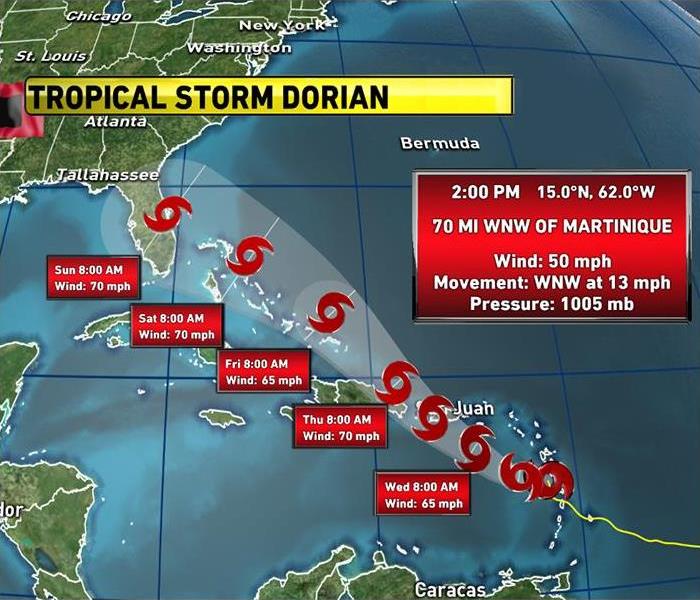Archived Storm Damage Blog Posts
How to Prepare Your Property for a Storm in Central Florida
6/29/2023 (Permalink)
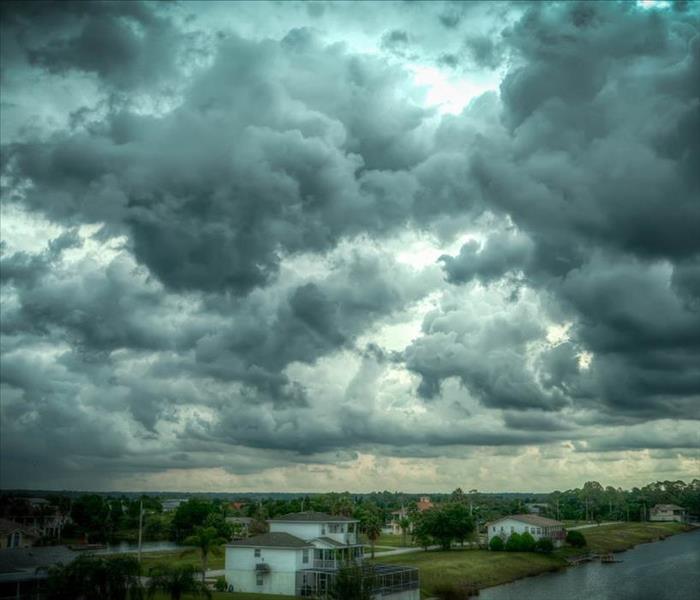 Florida is no stranger to frequent storms, especially during hurricane seasons.
Florida is no stranger to frequent storms, especially during hurricane seasons.
Living in Central Florida
Living here means being prepared for all kinds of storms, from hurricanes to thunderstorms. While you can't control the weather, you can take steps to protect your property from storm damage.
Here are some effective ways to prepare your property for a storm:
- Trim trees and shrubs away from your home or business. Fallen branches can cause a lot of damage, so it's important to trim trees and shrubs that could fall on your property during a storm.
- Inspect your roof for any damage. If you see any loose shingles or missing tiles, repair them as soon as possible. A damaged roof can let in water during a storm, which can cause extensive damage to your home or business.
- Secure loose items outdoors. This includes things like patio furniture, garbage cans, and toys. Anything that can be blown around by the wind can cause damage to your property.
- Bring in outdoor furniture and decorations. This will help to protect them from wind and rain damage.
- Disconnect any outdoor appliances or equipment. This includes things like lawnmowers, grills, and generators. If these appliances are damaged by a storm, it could pose a safety hazard.
- Have a plan for what you will do if you lose power. This may include having a generator, flashlights, and batteries on hand.
- Have a plan for how you will communicate with family and friends if you are separated during a storm. This may include having a designated meeting place or using a communication app like Zello or What'sApp.
If you do experience storm damage, it's important to contact a professional restoration company right away. Storm damage restoration companies can help you to assess the damage, remove debris, dry out the affected area, and repair or replace any damaged property.
SERVPRO of Winter Park is a leading storm damage and water damage restoration company in Central Florida. We have the experience and expertise to help you get your property back to normal after a storm. Contact us today for a free estimate.
Here are some additional services that storm damage and water damage restoration companies provide:
- Mold remediation: Mold can grow quickly in wet areas, so it's important to have it removed by a professional as soon as possible. Storm damage and water damage restoration companies have the experience and equipment to remove mold safely and effectively.
- Structural repair: If your property has sustained structural damage, such as a collapsed roof or a damaged foundation, you will need to have it repaired by a professional. Storm damage and water damage restoration companies have the expertise to repair structural damage and make your property safe to live in again.
- Content restoration: If your property has been damaged by a storm, you may need to have your belongings restored. Storm damage and water damage restoration companies can help you to salvage and restore your belongings, such as furniture, clothing, and electronics.
If you have experienced storm damage, don't hesitate to contact a professional restoration company. With the help of a qualified restoration team, you can get your property back to normal and start rebuilding your life.
How Hurricane Recovery Could Be Impacted by Lumber and Labor
5/31/2022 (Permalink)
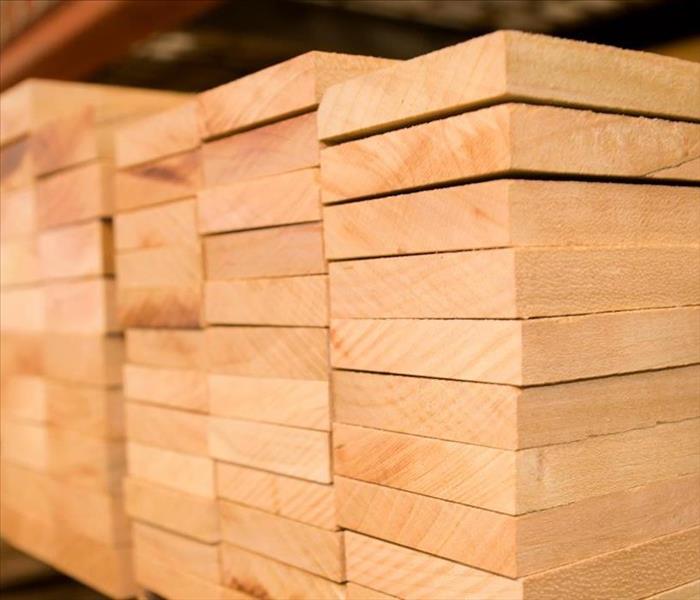 The cost of shipping lumber over long distances is difficult because of limited access to transport systems after a hurricane
The cost of shipping lumber over long distances is difficult because of limited access to transport systems after a hurricane
Hurricane recovery presents numerous challenges for the lumber and labor industry. Historically, lumber has been a vital component in many disaster areas as it is long-lasting and can be easily repaired when damaged. The industry has made significant efforts to ensure that wood materials are readily available in hurricane-affected areas during post-storm cleanup and reconstruction. In many cases, the cost of shipping these materials over long distances is difficult because of limited access to railroads or other transport systems after an event such as a hurricane.
How Hurricane Recovery Could Be Impacted by Lumber and Labor
1. High Prices for Materials Due to Outreach
Hurricane Michael was one of the costliest and most destructive hurricanes ever hit the United States. The most significant impact was along the Florida panhandle, which experienced high winds and torrential rains. Some estimates place the damage as high as $25 billion. This storm strengthened significantly before landfall, resulting in widespread devastation throughout a large geographic area.
2. Shortage of Lumber in Post-Storm Cleanup
During post-storm cleanup, lumber is used to repair damaged structures, and access is limited because many roads are impassable due to debris, fallen power lines, and flooding. Lumber is also used to construct temporary housing, set up shelters, and provide other necessities such as furniture and countertops. This limited supply of lumber must contend with high demand while being transported to help rebuild structures after a hurricane.
3. High Prices for Labor
Labor is required to rebuild structures, clear debris, and debris piles, repair infrastructure, and restore essential services such as electricity in the aftermath of a storm. Many disabled people need support during this period. Expanding the number of individuals employed in a wide range of age groups will help meet this labor demand.
4. Limited Population to Meet Demands
Many people affected by a hurricane are elderly or disabled, which means they cannot be relied upon to rebuild their homes and lives. Temporary housing is a temporary solution, which leads to the need for additional resources as the disaster area continues to rebuild services such as electricity.
5. Limited Availability of Labor Resources
Labor resources are usually located throughout the nation in professional debris removal and building trade companies. Unfortunately, many of these companies were destroyed in the hurricane and subsequent flooding. These companies may experience shortages of trained labor because many workers are now unable to work due to an inability to support themselves paycheck-to-paycheck due to demolished businesses or other factors affecting personal finances during the response period.
6. Logistics and Transportation
Trains and pipelines and roads and bridges may also be damaged after a hurricane. These road, rail, and water systems provide significant access to goods in disaster areas, resulting in the need for resources usually used to transport these goods. In extreme cases, transportation usually is delayed for several days before one can make repairs and goods can be transported.
Hurricane recovery is a critical period during which the lumber and labor industries play a significant role. Due to the economic impacts of past hurricanes, most consumers are willing to pay higher prices for materials and services to rebuild structures as soon as possible.
Flood Danger: Types of Floods
5/31/2022 (Permalink)
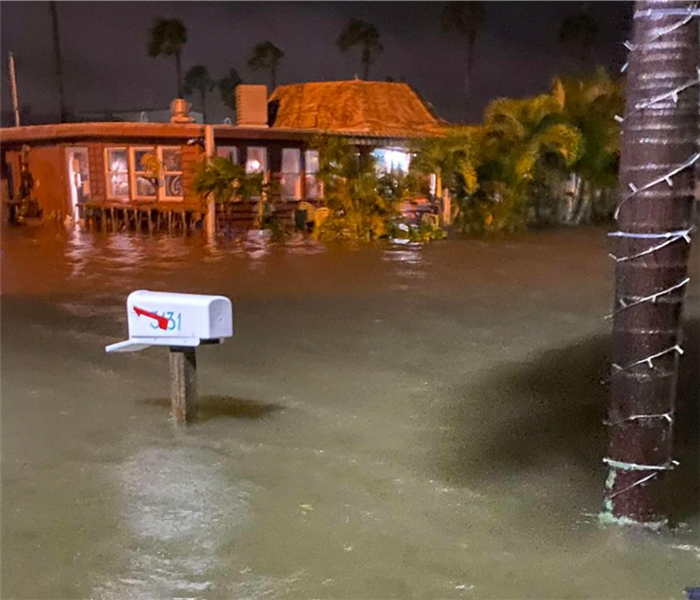 Floods continue to affect many people worldwide due to increasing populations and the destruction of wetlands and other natural barriers.
Floods continue to affect many people worldwide due to increasing populations and the destruction of wetlands and other natural barriers.
Flooding occurs when rainwater cannot drain quickly enough, causing floods to form on land and at sea. Floods continue to affect many people worldwide due to increasing populations and the destruction of wetlands and other natural barriers. Heavy rains are often the cause of flooding, but they may also be caused by other factors, such as melting snow.
5 Main Types Of Floods
1. Flashfloods
Most commonly known as 'whiplash' floods, sudden downpours of heavy rain cause flash floods. They usually occur in low-lying areas like river valleys and floodplains. Flash floods can be unpredictable - one moment, the ground is dry, and you can walk across; the next, a torrent of water rushes through, causing severe damage and drowning people who have been sight-seeing on foot. Flash floods can also be caused by heavy rainfall around or after rainfall has stopped.
2. Landslides
Landslides usually occur when the ground becomes saturated following heavy rainfall. When the rain ceases, the ground is left unsupported and begins to slide downhill. Landslides may occur on slope sides or in valleys but can also be triggered by ground-level heavy rainfall. Landslides are usually associated with rock, clay, and soil types that become slippery when wet.
3. Seepage
It is caused when surface water containing dissolved materials seeps into underground aquifers through cracks or fault lines. The water can then form into a saturated aquifer and start seeping up through the ground, through cracks and fissures in rock or faults. The ground can become unstable and cause landslides, floods, and earthquakes.
4. Tsunami
Tsunamis occur when a large volume of water piled in the sea causes a giant wave to break out over a wide area, generally around coastal areas. Tsunamis can travel at 600 km 373 miles an hour, destroying everything in their paths, including people, houses, and ships.
5. Storm surge
When a storm front passes over the sea from the ocean, it creates a wave that moves parallel to the coastline. If this is combined with high winds and waves already present in the seawater, the result can be storm tides known as storm surges. When they reach the coast, they cause widespread flooding on land around a country's coastline. In the UK, for example, storm surges can be caused by the extratropical cyclone created when warm air meets cold air over the sea.
A flood hazard map can show areas of risk and associated threat levels. The level of flooding varies from one flood to another in line with such factors as duration, intensity, frequency, and catchment area. Flooding in rivers occurs due to rainfall not being absorbed or held back by natural barriers such as wetlands and dams. When rainfall exceeds the capacity of natural barriers, water backs up. It can flood valley floors called flash floods or overflow into surrounding areas, often referred to as riverine flooding. A combination of flooding causes problems during extreme weather events. Landslides occur when saturated soil is loosened by rain or melting snow, and debris flows can follow heavy rainfall. Flood water then rushes down steep slopes in torrents causing rivers to burst their banks and inundate surrounding land.
2022 Hurricane Season Predictions
5/19/2022 (Permalink)
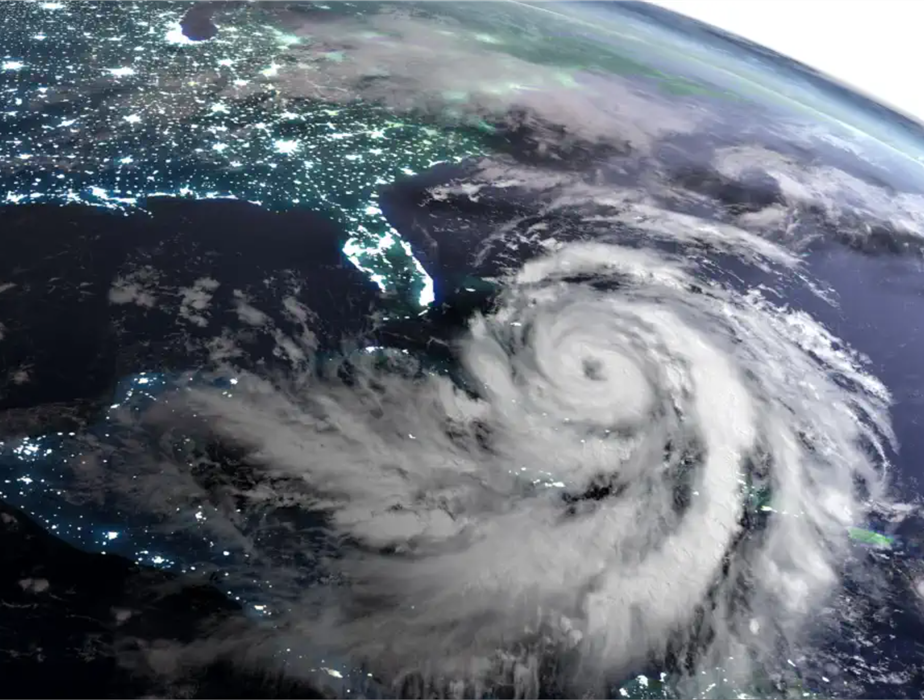 A major storm has not made landfall in Florida since 2018, however, experts predict a busier season this year.
A major storm has not made landfall in Florida since 2018, however, experts predict a busier season this year.
A hurricane is a severe tropical cyclone that forms over warm oceans. They're called hurricanes when included in the Atlantic and Eastern Pacific. In the Central and Western Pacific, they’re called typhoons. They’re known as cyclones in the Indian Ocean.
Hurricanes cause damage and destroy buildings by way of flooding and strong winds. These storms make them very difficult to predict and forecast, which causes problems for officials trying to prevent or prepare for hurricanes.
Forecasting difficulty
The difficulty of hurricanes comes from the fact that they form exceptionally quickly and can travel in very different ways. That’s why they sometimes cause mass destruction so suddenly.
Hurricanes are not predictable, especially regarding the size and speed with which they move. They do have a pattern of where they form in the ocean, but it is still not predictable. For example, you don’t know how far away pieces of the storm might be when it forms. If they’re far away, then they might help strengthen the storm.
The speed at which hurricanes travel is also unpredictable. They can move quickly over the water or come to a complete standstill. They usually speed up and travel faster than 80 miles (129 kilometers) per hour when headed to Florida.
Latest 2022 hurricane predictions in Florida
1. NOAA’s forecasts for the 2022 Atlantic hurricane season
NOAA (National Oceanic and Atmospheric Administration) has issued its outlook for the 2022 Atlantic hurricane season, predicting an above-normal storm season.
The anticipated increase in tropical cyclone activity is due to weak La Niña conditions observed over the equatorial eastern Pacific Ocean and favorable atmospheric conditions in the tropical Atlantic.
The Atlantic hurricane season is expected to have an above-normal number of named storms, with a 60% chance that there will be between 8 and 13 named storms (with winds reaching 39 mph or higher).
2. AccuWeather’s latest forecast for the 2022 hurricane season.
Accuweather has issued its outlook for the 2022 tropical cyclone season, predicting it to be an active one.
AccuWeather’s outlook for the season also indicates a 60% chance of between 8 and 13 named storms with winds reaching 39 mph or higher.
The seasonal outlook indicates a 30% chance that the season will have more named storms than expected, a 15% chance of having an equal number of named storms, and a 12% chance of having fewer named storms than usual.
3. The Florida Scientist’s forecast for the 2022 hurricane season.
The Florida Scientist has issued its outlook for the 2022 Atlantic hurricane season.
Theologist forecasters expect a below-average to near-normal 2018 Atlantic hurricane season, with a 50% chance that it will be above average and a 50% chance it will be similar to 2017. The outlook indicates an 80% chance that the season will have fewer named storms than usual and a 20% chance of having more named storms than average.
4. The Weather Company’s latest forecast for the 2022 hurricane season.
This season will be below average to near average in terms of the number of named storms and above average in the number of hurricanes.
Classic El Niño, or warm water conditions in the equatorial Pacific Ocean, were expected to affect atmospheric conditions over the western tropical Atlantic during the fall of 2018 into 2019, which could lead to an above-normal season this year.
According to the outlook, a 70% chance (range 50-90%) of 9 to 15 named storms, of which 4 to 8 are expected to become hurricanes (range 2-6), including 1-4 major hurricanes (category 3, 4 or 5; winds 111 miles per hour or more significant) this season. There was a 40% chance (range 30-50%) of an equal number of named storms and hurricanes.
Seasonal predictions
There are many different ways that experts predict the amount and strength of hurricanes this year. The most serious ones have indicated a declining trend in the number of storms every year. Hurricane season runs from June 1 through November 30.
There’s also an ongoing forecast for where these hurricanes will form in September, October and November. This is based on the predictions for El Niño, which is typically active during the summer months. The forecasts say fewer hurricanes will be formed in the Pacific Ocean this year.
Forecasters also use an official storm track to predict where these storms may form. This is based on weather patterns and ocean temperatures across the globe. It’s not something that can always be used since it is unpredictable, but they can predict where hurricanes will form and how they could affect Florida with this information.
Safety measures
There is something called hurricane shelters used for people to go to when a hurricane is coming. They are all underground so that the people who go there can safely ride out of the storm. This is where most of Florida’s population goes during hurricane season. The Federal Emergency Management Agency (FEMA) has a map online which shows precisely where these shelters are located within the state.
Sometimes, the National Guard will help clear storm debris and ensure that everyone in the area is safe. They are also the only entity in Florida that has the right to enforce a statewide curfew. They can do this when they have enough people available to implement it, and they will use it to make sure that everyone in Florida, including children, is safe.
Emergency water supplies are needed during hurricane season, so people should discuss what they need with their local authorities as soon as possible. This includes drinking, cooking, and cleaning supplies once a disaster occurs.
Many hospitals use generators during hurricane season to remain fully operational even when the power goes out. This is especially true in emergencies when they are needed to operate on many patients due to storm injuries.
During hurricane season, specific equipment is required for having electricity and communicating with the outside world. If a hurricane knocks out the power in Florida during hurricane season, everyone needs several days’ worth of batteries and flashlights in an emergency.
During Hurricane season, you should plan for emergencies that may occur and make sure that you have medical supplies on hand in case of an emergency during hurricane season.
Hidden Roof Damage After Florida Storms
11/19/2021 (Permalink)
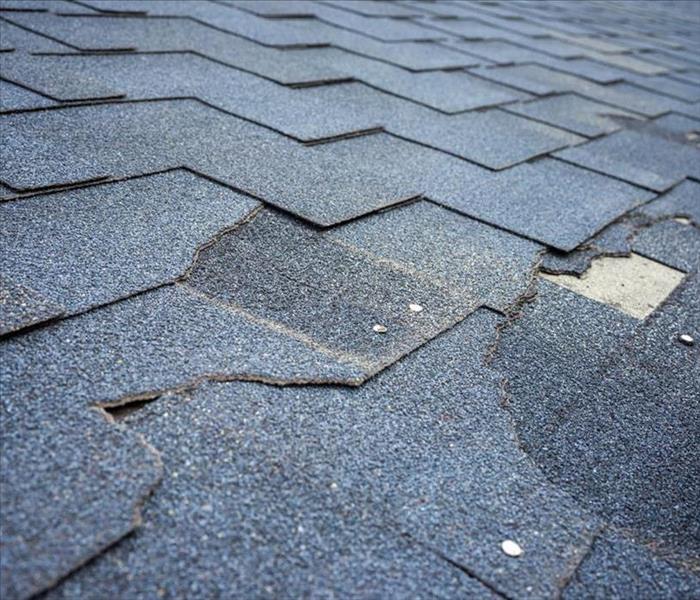 Roofing repair can be a complex task that involves expensive tools and repair methods.
Roofing repair can be a complex task that involves expensive tools and repair methods.
The Sunshine State is world-famous for having one of the best developed living environments and weather. However, it's also prone to various extreme weather issues, which can eventually have its toll on items such as your home.
Unfortunately, a portion of the damage that occurs to your property is sometimes difficult to detect. You have to be concise in your search for any hidden property damage to ensure the best results. However, there is more to searching for progressive storm damage on your property than you would expect.
The Potential for Hidden Roof Damage After Storms
Weather damage is highly likely in Florida. Instead of using a reactive approach when your property falls victim to such weather, use a proactive approach. Part of this approach is in being aware of the potential of storm damage and creating a suitable response plan for the same.
Florida might be one of the most serene states in the country, but extreme weather issues are sometimes rampant in the city. While snow blizzards are not likely to occur, the Sunshine State still experiences various other forms of poor weather.
Common occurrences include watersports, heavy rain showers, tornadoes, hurricanes, and more. The Sunshine state tends to experience humid and subtropical climates, making it the perfect environment for such weather conditions.
Modern weather planning and forecasting have made it easy to prepare for such events in the future. However, this is still not sufficient to ensure that your property is safe from hidden roof damage. You have to consider various other alternatives in your approach to preparing for storm damage.
The common alternatives you have to consider include insurance coverage and help from a reputable roofing repair service. You need a reputable service because roofing repair can be a complex task that involves expensive tools and repair methods. With a reputable service, you are sure of accessing such expertise at reasonable prices.
How Storm Insurance Works
Looking back on damage from hurricanes such as Michael or Andrew, Florida has experienced some of the most extreme weather in history. Each year, the possibility of an unusual weather event is a reality for all Florida residents. Since most high-quality roof repair procedures are costly, you need suitable insurance to cover your risk management needs.
As a responsible property owner, you must safeguard your property from such forms of extreme weather. Below are some helpful tips on things you need to know about storm insurance in Florida:
What is Storm Insurance?
Storm insurance can lead to two main types of damage, which can occur due to water or wind. You need to invest in the right storm insurance or a suitable policy that you can use to safeguard the welfare of your property.
Instead, consider a unique combination of insurance services that will cover any form of damage your property will face. Part of this insurance coverage will include roof damage after storms.
Your storm insurance might also include the specific details you had identified with your insurance agency. It's part of the process involved in creating custom coverage plans for properties based on their market value.
How Much Does Storm Insurance Cost?
It's not easy to determine the specific amount you require to safeguard your property against storm damage. The reasons why it's difficult to do so can include:
- Storm coverage often includes several insurance policies, each with a different pricing level.
- Prices can shift among different service providers.
- Some parts of Florida are more prone to storms than others.
- The value of a property has an impact on insurance coverage costs.
While there is no specific metric on the average cost of storm insurance in Florida, we can use other similar estimations to get a perspective. A good example would be that flood insurance averages at $700 and hurricane damage would be $2500.
Property and homeowners are also under the obligation to make up for specific insurance fees. The fees come from recommendations through the National Weather Services and include damage. The insurance coverage goes by the name Hurricane and Windstorm Deductibles.
The fee applies to up to 17 states in the city and specifically covers property damage from windstorms and hurricanes. Since storms are the leading cause of hurricanes, you may find this insurance type helpful.
Even if you have insurance coverage, you might also need the help of a lawyer in processing your claim. Doing this ensures you are safe from contract coverage and can receive all the compensation for the roof damage.
A good lawyer can help you to avoid malicious agencies that often give the following excuses:
- Delaying with your property damage compensation claims.
- Creating insufficient offers that don't address all the damage to your property.
- Inclining, you sign new agreements with unusual or adjustment claims.
- Claiming that hidden room damage is not part of your insurance coverage.
Using a Restoration Service for Damage
You will need a restoration service if your property has hidden roof damage. Below are some of the reasons why you need a restoration service:
Access to Trained Professionals
The first benefit of working with SERVPRO of Winter Park is gaining access to highly trained and experienced professionals. The company handpicks these professionals based on certain factors such as experience level, job qualifications, and personal values.
Doing this helps us ensure that we can assign your property to people who can give you valuable solutions. Our team can also provide customized property solutions for your unique roofing needs. We also ensure our professionals stay updated on modern roofing products that can be suitable for your property.
Satisfaction Guarantees
We provide several satisfaction guarantees for our clients because we know the importance of having a good roof over your property. These satisfaction guarantees come from the several hours we have worked to provide suitable solutions to consumers.
We even have access to information on the best insurance coverage offers that you should consider. Our team will help you choose high-quality and affordable coverage premiums that you can use. The satisfaction guarantees also include warranties for any damage that occurs due to our products or services.
While it's unlikely that you will dispute, we want you to be aware of the extent of our roofing service guarantees. So, our roofing repair procedures are only complete when you are pleased with the final result.
For Safety
Fixing a roof is no ordinary DIY task. You have to be thorough and safe in your approach to ensure the best results. That is why we have an extensive team of professionals available to help restore the property's value for safety purposes.
We have all the right resources to access the most remote parts of your roof remotely. Without a solid roof on your property, occupants are also prone to various problems such as poor weather and even wild animals.
Safety is one of the main reasons SERVPRO of Winter Park recommends you never work on hidden roof repair damage DIY. You need someone who can identify such damage in your property and orchestrate a suitable repair plan.
Access to Quality Roofing Solutions
Our team has worked on roofing solutions for many years. We have the right experience to tell you what works best for your property. Our in-field team is regularly interacting with these roofing products and defining customer needs.
Each solution we provide comes from hundreds of hours of in-field experience and consultation with industry experts. Aside from fixing your property, our team will also give you helpful advice on managing roofing damage issues in the future.
We can advise you on risk management, damage identification, DIY suggestions, and insight into cutting-edge roofing solutions. We also give free quotations to determine the scope of our services and prepare for the roofing repair project.
As you have seen, there is more to fixing and preparing for hidden room damage issues than you would expect. You need the help of a professional service provider and a reputable insurance agency. Using this approach will help provide the best roof damage repair benefits for your needs.
Florida Roofing Insurance Claims
11/19/2021 (Permalink)
 Fixing a roof or replacing one altogether is typically a large and expensive undertaking. Understanding how Florida roofing insurance works can help.
Fixing a roof or replacing one altogether is typically a large and expensive undertaking. Understanding how Florida roofing insurance works can help.
Insurance claims are often a contentious time, but there are ways to make the process easier. If you need to file an insurance claim for your roofing, here's what you can do to prepare. If you're filing an insurance claim for your Florida home or business, you must know how the process is going to work. Knowing what you can expect from your insurance company before they get there, or even while they're on the scene, will make sure that everything goes according to plan and no one gets surprised along the way.
In most cases, roofers will need to file a homeowner claim if their roof has been damaged by a storm. If the roof is beyond the scope of your homeowner’s policy, then it will need to be filed as a commercial claim. Florida has specific laws regarding insurance claims that vary from state to state, so this article will focus on general guidelines. Florida law requires property insurance companies to follow these guidelines:
1. Emergency Services
If you need to call a roofing contractor because of damages caused by a natural disaster or accident, have them on-site as soon as possible. Your insurer will expect the damage to be assessed and for a contractor to be called immediately and is required by law to reimburse you within 45-60 days. In addition to keeping good records for your insurance claim, you should also take pictures and videos of the damage and send them to your insurer right away.
If you need to make emergency repairs in order not to further damage your home or business, be sure that you get a contractor on-site as soon as possible. The contract must contain a provision authorizing emergency services which is written in plain language without legal jargon, and it should only apply if there was no opportunity to obtain such services from another source. If this condition is met, then the insurer can authorize necessary roofing repairs up to 10% above the policy deductible limit (Florida law requires this amount be paid within 15 days).
2. Documentation of Loss
Insurers will require a list of any damaged items and detailed documentation of the damages they've suffered. This includes estimates for repairs, pictures, or receipts for appliances that have been lost or damaged in the process. All documentation will need to include dates and times where possible. Furthermore, you must keep all invoices and documentation for at least five years after the repairs.
3. Minimal or No Pre-Existing Damage
If your roof has previously been damaged, even if it was repaired, then your insurer may not be required to pay for the new storm damage. This varies depending on the state and whether there was any chance of repair before the next storm struck. If there is damage due to previous storms that were unreported, insurers will only be responsible for current and/or future losses caused by hurricanes or other major natural disasters.
While taking photos of existing damage prior to filing an insurance claim is important, it can also help with determining if recent storms have caused additional damage as well. If you find damage that has been repaired, you'll need copies of the contractor's work order and copies of the payment receipts for your insurance claim.
4. Damage Appraisals
Florida law requires property insurers to provide a valuation of damages within 60 days after an appraisal has been completed by an independent company. If there are any disputes regarding the appraised value, then you can file mediation or arbitration which will be overseen by the state's public adjuster board. You must also receive written notice before filing with this board. When negotiating an insurance claim settlement, it is helpful to have roofers on-site as soon as possible to ensure that expensive repairs aren't being overlooked beneath layers of debris. They may even be able to prevent further damage from being caused by a leaky roof.
5. Disaster Fraud
Florida is one of the states that have been hit hardest by hurricanes in recent years. Hurricane Irma alone led to over three million insurance claims, many of which could end up being fraudulent. While it may be difficult for you to spot disaster fraud within your own insurance claim, there are some signs that indicate possibilities for false documentation or inflated claims:
• Damage seems inconsistent with previous damage from a similar storm
• Payments from multiple insurers were requested before work was even finished after a single event
• Bills show incorrect dates and times where possible
In cases like these, you will need an experienced property insurance lawyer who can carefully review all documentation provided for your claim and help enforce your rights to a fair insurance claim settlement.
6. The Claims Process
Your insurer will file a claim and an adjuster should arrive to inspect your damages soon after your initial call. They will start by assessing the damage, and if they need you to make any repairs or move items before they can do their inspection, they should let you know when you can expect them back.
Moreover, it's a good idea to ask questions as they come up, but waiting until the end of the process is not recommended. Once your insurer has received all necessary documentation and completed their inspection, you will either receive an offer if your damage was less than the policy deductible or be asked for final approval before repairs are made.
In some cases, insurance claims can go on for months or years without ever being resolved by your insurer because of fraudulent claims or incomplete paperwork. If this happens to you, don't hesitate to contact a lawyer who specializes in home insurance claims. Although hiring a lawyer may cost more money upfront, they can help ensure that you don't have to wait any longer than necessary.
7. Miscellaneous Costs
If there is no deductible in your policy, then the insurance company will handle all costs related to your roofing repairs above and beyond what is covered in your policy up to $10,000 without requiring a signed agreement. If there's a deductible in place, the amount paid out to cover miscellaneous expenses may be reduced accordingly.
However, these miscellaneous expenses are not restricted to things like moving services, board-ups, or emergency repairs. They also often include costs associated with rental properties or hotels if you need to be moved somewhere else for an extended period of time during the roofing repair process.
If you do have a deductible in place, then it is your responsibility to cover all of these extra expenses unless they're the result of negligence by the insurance company. Your insurer may make you pay a higher premium next year if they've had to pay out too much money on your behalf because of a poorly documented claim.
8. Communicating with Insurers
Keeping your insurer up to date with any changes in the amount and type of damage done by a storm is critical. Any changes that you need to file before they arrive should be communicated as soon as possible and no later than 2 business days after you've had an inspection.
This communication may include:
• Damage assessments
• Estimates for repairs
• Replacement items; such as appliances or flooring
• Construction plans
9. Your Rights
During the claims process, it's important to know what rights you do and don't have under Florida law.
These rights include:
• The right not to be discriminated against because of your disability or religion
• The right to receive prompt payment when applicable
• The right not to pay a deductible more than once per claim
• The right not to receive less than the actual cash value of damaged goods
Conclusion
Roof insurance claims can get extremely complicated very fast, so if you need help from an insurance attorney to file a claim it's vital that you contact one as soon as possible. Any roofing insurance claim in Florida is subject to the same laws and regulations and should be processed in a timely manner (generally within 45-90 days). It's important not to wait until your claim has been denied before seeking help from an attorney, as this could result in further complications.
A roofing contractor can help prevent further damage from being caused, but you need legal assistance when filing an insurance claim in Florida in order to ensure that the damages documented are covered under your policy and your insurer is not required to pay more than what was originally offered. In conclusion, you should consider hiring a lawyer if your insurer fails to recognize damages caused by the storm.
Going to a Shelter in the Event of a Hurricane
6/15/2021 (Permalink)
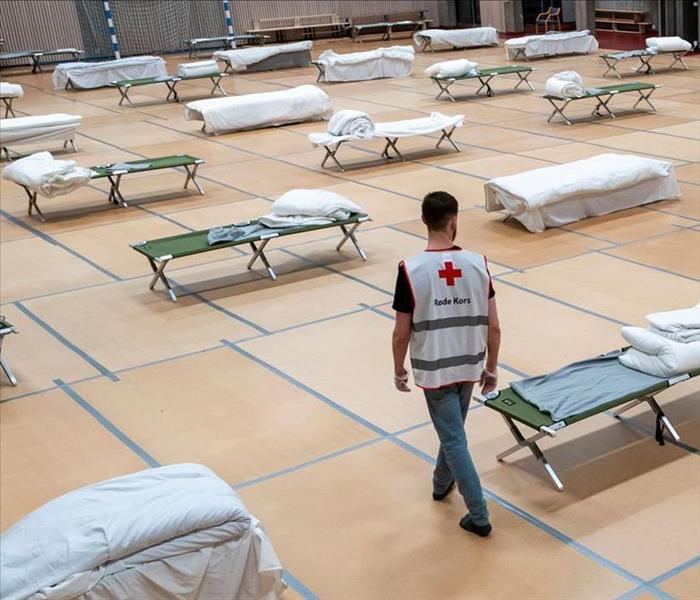 Hurricane shelters are taking the current pandemic into consideration when setting up in the event of a hurricane.
Hurricane shelters are taking the current pandemic into consideration when setting up in the event of a hurricane.
Going through an emergency situation, such as a hurricane, that requires you to evacuate your home can be very scary. Fortunately, proper preparation makes the process easier for everyone involved. While many steps in the replacement process may seem common knowledge, in the heat of the moment, there are things that can be forgotten. The following guide walks you through tips to use if you need to evacuate your home to go to a shelter during a hurricane.
Reduce the Risk of Catching COVID-19
One of the most important things you can do to prepare for potential relocation during a hurricane is to get the COVID-19 vaccine in advance. When you’re in a storm shelter, there are often many people in a confined space. This means the transmission of the virus will be much higher than if you were merely out and about doing your normal daily activities. The COVID-19 vaccine is taken in two separate doses and requires a brief window between the two doses, so getting started with the vaccine process as quickly as possible is essential.
Determine Where the Closest Shelter is Located
When evacuations occur, many people become frantic because there are so many things they need to do to prepare for their shelter stay. Taking the time to find out where your closest shelter is before any hurricanes arrive can take away some of the stress that comes during this hectic time. It’s a good idea to determine a safe route of travel in advance too. You want to be sure you don't have to travel through any roads that could potentially flood during a hurricane. This ensures you and your family can get to safety as quickly as possible.
Don’t Forget About Your Pets
Many shelters restrict pets from being able to stay on the premises for their safety and the safety of others on site. It’s important to make arrangements for your pets in advance so you have a safe place to take them if you do need to evacuate your home in the future. There are many kennels that house pets during emergency situations, but they often have limited capacity available. Making arrangements ahead of time betters your chances of being able to get them to a safe place during an emergency.
Talk to Your Family about a Potential Evacuation
The evacuation process can be scary for children so talking to them about what to expect before a hurricane hits can make the transition easier for them and for you. Explain the process that will take place and what they can expect at the shelter. Explain that there will be a lot of people in the facility and they need to stay with the family at all times. Explain how important it is to wash their hands frequently to prevent the transmission of any illness, including COVID-19. Explain that there will be very limited things for them to do to stay occupied so they need to determine what items they want to bring with them for entertainment.
Create a Checklist
It’s a good idea to create a checklist for the things that need to be brought to the shelter. A few things to consider bringing are:
- Water: While emergency shelters often have water available, the quantity may be limited and it could take a few days for emergency supplies to arrive. Packing water for your family ensures everyone can stay hydrated during the stay.
- Food: If anyone has dietary restrictions, bringing food with you ensures they get the specific foods they need. It’s a good idea to bring foods that are precooked and easily eaten without needing to be heated. It’s also a good idea to pack a few comfort foods, such as snacks, cookies, or fruit so everyone can feel as comfortable as possible.
- Medications: When staying in the shelter, you won’t have access to a pharmacy and thus need to bring any medications your family needs with you. Be sure to bring ice packs and a cooler for any medications that need to be refrigerated and refrigeration may be limited.
- Clothing: Clothing needs to be brought with you to the shelter as you may not be able to return to your home for a few days. It’s best to try to pack clothes in the most compact way possible as the amount of space designated for your family will be limited.
- Sleeping Bags: The number of cots available to shelter attendees will be limited. Bringing sleeping bags with you to the shelter ensures everyone in your family has a warm place to rest.
- Crucial Paperwork: Bring all important documentation with you when you evacuate. If something happens to your home during the hurricane, you can rest assured the important documents your family needs do not get damaged or destroyed.
- Entertainment: Staying in a shelter can become boring over time. Bringing card games, books or other forms of entertainment can help keep boredom away. It’s important to not rely solely on electronic devices for entertainment. Access to electricity may be limited and make it difficult to charge devices when needed.
Local storm shelters in central Florida can be found in Orange County at Barnett Park Community Center, in Seminole County at Northland Church, in Volusia at Ocean Center, and in Osceola County, the listings are provided when an emergency occurs. If a hurricane does damage your home, SERVPRO is ready and willing to get your home back in order so your family can return to normal life as quickly as possible.
How Tropical Storms Can Cause Property Damage
5/19/2021 (Permalink)
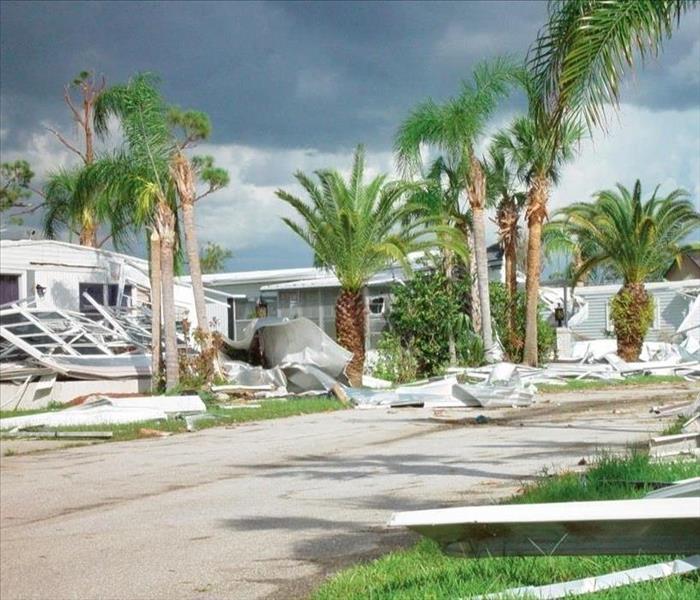 Although not as strong as a hurricane, tropical storms still have the potential to cause extensive property damage.
Although not as strong as a hurricane, tropical storms still have the potential to cause extensive property damage.
Many people across the country watch the news of tropical storms battering Florida. They wonder what the big deal is, because it's just a lot of rain and wind, right?
They've forgotten the damages from the rain and wind of a tornado or other severe storms in their area. Let's examine what property damages are possible from a tropical storm in central Florida.
Property Damages From Rain
Tropical storms deliver rather impressive but torrential rainfall. Rain of over six inches could cause destructive flooding. Flooding of inland properties both commercial and residential is the first big result of tropical storms.
Roof shingles and tiles are not only infiltrated but torn off. This causes ceiling damages in the rooms beneath. Windows could possibly leak with torrential rains. Foundations can be harmed and basements flooded.
Chimneys could take on water. The floor of the room in which the fireplace is located would flood. Gutters could fail under so much rain. This would mean water damages to the walls, resulting in mold and mildew.
Property Damages From High Winds
There's a reason central Florida cities get the evacuations done before the high winds of a tropical storm begin blowing. Persons caught outdoors are urged to get inside before the storm starts. Here's why:
- Flying objects. Anything not tied down or brought inside morphs into a projectile hurled as if by angry gods. Fence rails, lawn furnishings, rakes, shovels, toys, and decorative stones could all crash through the walls of a house.
- Parking barriers, anything in the bed of a truck, and road signs could pierce the walls of a commercial enterprise. It takes a lot for clean-up crews to gather the projectiles and for repairmen to repair the damages done by tropical storms playing catch with commercial and residential buildings.
- Building materials. High winds snatch at things. We've seen fences picked up out of the ground by high winds. Roof tiles, ripped siding, even stone veneers can be snatched out of their resting places and tossed around in the wind.
- Blown away. The higher a building is, the more delight tropical storm winds take in putting their shoulders into it. High buildings can topple. Homes and lower-built commercial buildings have been known to be moved off their foundations by capricious tropical storm winds.
Property Damages From Storm Surge
The record for a storm surge during a tropical storm was in Australia in 1899. The surge traveled 13 miles inland, wreaking havoc along its path. Storm surges can travel up to 30 miles inland.
The problem with storm surges is that it eats away at both the land and buildings on it. Erosion happens to both land and highways. It can undercut the foundations of buildings as well as cause rising waters from local rivers and lakes. As high winds drive deadly rushes of water inland, it's a wise idea to run.
Property Damages From Tornadoes
The fury of movement inside a tropical storm spawns tornadoes. Also furiously moving, tornadoes wreak just as much damage as tropical storm winds and rain. Tornadoes, however, are capricious in the extreme. There's no telling which way they'll turn, how much damage they'll feel like doing, or when they'll exit stage left.
Tornadoes have been known to stomp houses into the ground, pick up mobile homes and deposit them miles away, collapse commercial buildings, snatch up trees and toss them into someone's house or store, take cars out for a spin, and make boats completely disappear.
All this is bad news to those living on houseboats, beach houses, and cabins on the lake. These places aren't only located on coasts battered by tropical storms; they're located inland on lakes and rivers. While there are warning systems in place all over Florida to alert people to the approach of a tropical storm, not everyone wants to give up control of their property to winds and rain.
Final Thoughts
The death toll following these awful storms is worse than the property they damaged. We can replace a house or a store, buy another boat or car, but we can't replace those who died trying to protect their property.
There are companies like SERVPRO of Winter Park that clean up after such a storm. The property can be put back together in time. The most important thing is to preserve the lives of the people owning the property. Heed the warning calls, and then call on the pros to fix everything afterward.
The 2021 Atlantic Hurricane Season Is Upon Us
5/6/2021 (Permalink)
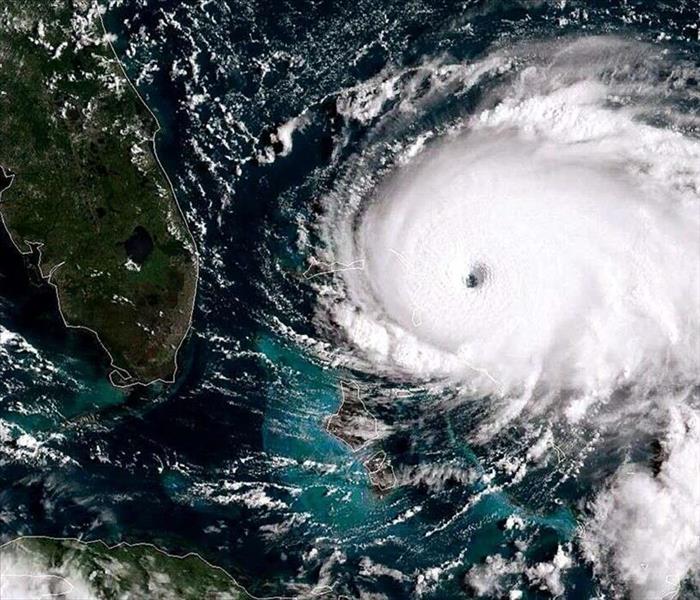 A recent forecast anticipates an above-average probability for major hurricanes to make landfall along the United States coastline.
A recent forecast anticipates an above-average probability for major hurricanes to make landfall along the United States coastline.
2021 Atlantic Hurricane Season Forecast
Predictions so far forecast a milder season than last year, but still a very active one. Reading these predictions for 2021 will give you the ability to prepare.
2020 Hurricane Season
The 2020 Atlantic hurricane season was one of the worst on record. There were 30 named storms, the highest number ever recorded. Meteorologists switched to Greek after exhausting the 21 letters of the English alphabet that are used in naming hurricanes. Also battering the coast that year were an extraordinary 13 hurricanes, with 6 that fell above a category 3.
For context, the average year has 12 named storms, six hurricanes, and three major hurricanes. A storm considered a major hurricane, higher than a category three, will have recorded winds at 115 miles per hour or higher. Category five hurricanes have wind recorded at 157 mph or higher. Comparatively, tropical storms have sustained winds of 73 mph, and regular hurricanes will have sustained winds of 74. The 2021 hurricane season starts on June 1st and lasts all the way until November, and the typical month with the most hurricanes is September--but the strongest ones usually occur in July and August.
Why Are Hurricanes Seasons More Active In Recent Years?
One of the reasons for more active seasons in recent years is global warming. A hurricane is created when high-pressure air combines with low-pressure air over warm waters, heating the moisture in the air. That warm low-pressure air then warms the high-pressure air, and the air begins to rise. As this air rises, it cools off. So in order for a hurricane to form, you need low air pressure, warm, humid ocean air, and wind. This creates the large storm clouds and front characteristics of a hurricane and gives it the steam to continue to build as it moves through warm waters. Hurricanes cool off as the water gets colder, which is why most hurricanes stay in tropical waters.
However, due to global warming, the greenhouse effect is warming waters further still, essentially sending a blast of energy through these hurricanes. Global warming causes not only warmer waters around the equator but increased precipitation and stronger winds.
What To Expect This Year
Various meteorological agencies have already released their forecasts, with NOAA's being the highest at 13-20 named storms and an average of 6-10 hurricanes with 3-5 of them being strong hurricanes of a category 3 or higher. Colorado State also made some predictions, forecasting 17 named storms, eight hurricanes, and four major hurricanes. That would make 2021 the sixth consecutive above-average hurricane season.
Florida
The Sunshine State is always in the spotlight during the Atlantic hurricane season, as the gulf maintains typically warm waters and the panhandle is usually right in the center of the projected paths of storms formed at the equator. Colorado State projects a 45% chance that a hurricane will hit the eastern US coast this season, including the Florida panhandle. The average chance of this in any given hurricane season is 31%, a significant difference. They also project a 69% chance of a hurricane hitting any part of the US coast (average 52%) and a 44% chance of a hit anywhere from the Florida panhandle to the Texas coast (average 30%).
So there is a higher-than-average chance that some part of Florida will see hurricane action this year. In order to understand the probability of where the hurricanes might hit, we can look at the historical records of where hurricanes have hit Florida in the past.
Northwest Florida, situated on the state's panhandle has suffered a total of 66 hurricanes, including 14 over a category 3. Because this region is technically outside the tropical zone, temperatures are lower, which creates that contrast in pressure that fuels warm-weather storms. It is interesting to note that all of the category 4-5 hurricanes that hit northwest Florida occurred after 2018; between 1815 and 2017, all of northwest Florida's major hurricanes were category 3.
The second-most hit region of Florida is the southeast with 44 hurricanes on record. This area of Florida has endured seven category 4 hurricanes, as many as the entire state of Texas.
Northeast Florida has had 26 total hurricanes, making it third on the list. The safest areas in Florida are the most inland because hurricanes nearly always lose steam and energy when they hit land, and the more inland an area is, the more time the hurricane has to cool off. This is why coastal areas typically suffer the most damage.
As you can see from these statistics and predictions, elevated hurricane seasons are not likely to calm down--although we may see a less turbulent season than that of last year. Northwest Florida is likely to see the most action, with the Southeast second-most likely. Depending on where you live, these statistics can help you prepare for this year's hurricane season.
2021 Hurricane Names
5/6/2021 (Permalink)
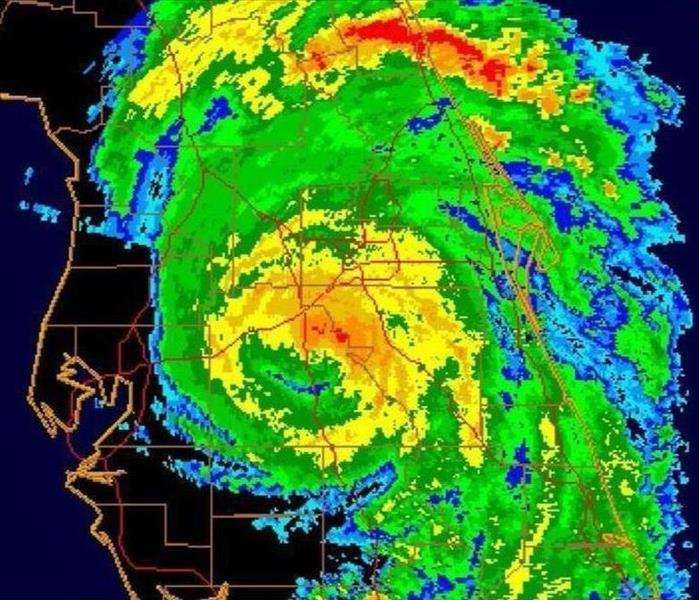 Some hurricanes have their names remembered much longer like Hurricane Charlie that ravaged Florida in 2004.
Some hurricanes have their names remembered much longer like Hurricane Charlie that ravaged Florida in 2004.
Hurricane Names for the 2021 Season
Although a hurricane or tropical storm isn't confined to certain dates on the calendar, June 1 through November 30 is considered Atlantic hurricane season. In advance of this season each year, the World Meteorological Organization releases the list of names to be used on tropical storms and hurricanes that year. This list goes in alphabetical order and alternates between male and female names. The lists feature 21 names, with the other five letters of the alphabet being skipped for a lack of available names associated with those letters. Each of the lists is used on a rotating basis every six years to simplify the naming process. This means that the list used for the 2021 season is the same as that used in the 2015 season.
The only changes made to the list are retired names. Storm names are occasionally retired when a tropical storm or hurricane is especially costly to an area or deadly, as using the name again is considered insensitive. For example, Hurricane Joaquin slammed the Bahamas in 2015, causing 34 deaths while Tropical Storm Erika rolled over the Antilles and caused 31 fatalities. These two names were retired from the list in 2015. Other notable names that have been retired over the years include Katrina, Harvey, Irma, Ivan, and Stan. The letter I leads the list in the number of names retired from the list at 11, followed by nine each for C and F.
During a particularly active tropical season, this list of names may be all used up, in which case an extra list is used for backup. This backup list used to be based on the Greek alphabet but is now simply another 21-name list following the same male and female rotation.
The list for 2021 features the following names:
1. Ana
2. Bill
3. Claudette
4. Danny
5. Elsa
6. Fred
7. Grace
8. Henri
9. Ida
10. Julian
11. Kate
12. Larry
13. Mindy
14. Nicholas
15. Odette
16. Peter
17. Rose
18. Sam
19. Teresa
20. Victor
21. Wanda
Business Recovery After a Natural Disaster
10/20/2020 (Permalink)
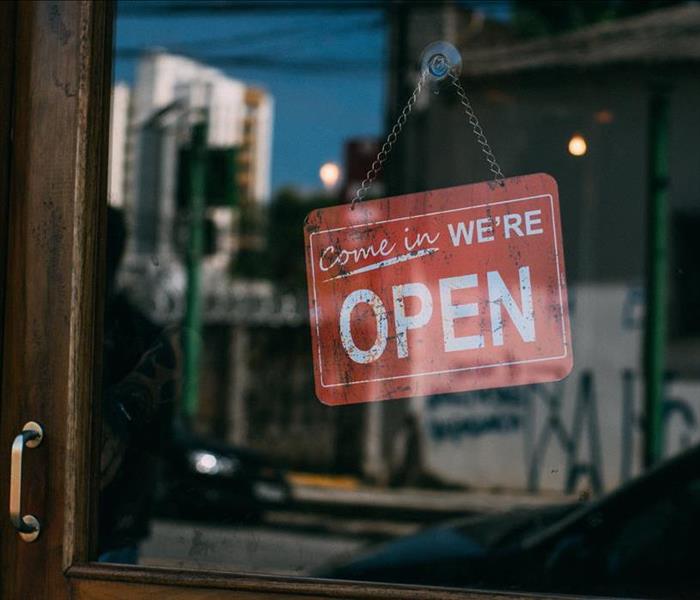 A natural disaster has the potential to cripple a business. Preparing yourself adequately before one can ensure your business has minimal downtime.
A natural disaster has the potential to cripple a business. Preparing yourself adequately before one can ensure your business has minimal downtime.
Reopening a Business After a Natural Disaster
The U.S. has sustained 279 natural and weather-related disasters since 1980, with damage repairs costing in excess of $1 billion, according to the National Centers for Environmental Information. Only about 40% to 60% of small businesses that are affected by a natural disaster reopen their doors, according to the Federal Emergency Management Agency (FEMA).
Some natural disasters, such as a hurricane, are predictable and allow business owners the time they need to prepare. However, many natural disasters, such as wildfires, may occur without warning, leaving no time to ensure a business is safe and prepared.
As a small business owner, creating a disaster preparation plan and ensuring you’re ready for any type of devastating event is key to your business’s survival. Review the information below to learn how to reopen your business successfully after a natural disaster.
Emergency Plans
Your emergency plan is a crucial part of your business’s survival and your employees’ safety, both during and after a natural disaster. While you may feel you’ve created a comprehensive continuity plan that thoroughly addresses every aspect of your business, natural disasters can be unpredictable. The aftermath of a weather-related event may pose problems you didn’t foresee that haven’t been addressed in your general operational plans.
When you create an emergency plan, consider how to keep your equipment, environment, and staff safe in different scenarios. You should:
- Analyze potential threats related to precedented, regional, and seasonal natural disasters.
- Consider how to deal with business interruptions.
- Create a work plan for employees and vendors.
- Choose a professional cleanup and restoration company that will help your business estimate the costs of repairs or even remediation to help increase the resilience of your permanent locations.
Consider all aspects of the natural disasters that may threaten your business at any point in time and create a plan that addresses these potential scenarios. Once your emergency plan is in place, implement the steps when it’s safe to do so. When you follow your plan, major issues and barriers are easier to tackle because you’re better organized and prepared.
Documentation and Insurance
Once a natural disaster occurs, it’s crucial to document the damages and losses your business suffers. Keep track of receipts and purchases you made to mitigate damages. Document your business’s current physical state with photos and videos.
Before providing compensation for mold remediation services or other aid, your insurance company may ask to see proof of damages. If you need smoke or fire remediation, the insurance company may request photos of the damage to your equipment and building first. Documentation of your property before disaster strikes can help you make your case and potentially expedite the aid you need to get back up and running. Likewise, retain any receipts for expenses incurred after the disaster, as your insurance company may not compensate you without a clear record of expenditures.
Constant Communication
Open lines of communication are the key to getting your business back on track and fully recovered from a natural disaster. Be sure your employees are aware of your recovery plan and their roles in each step. To keep the recovery process running smoothly, you may need to maintain constant communication with:
- Your insurance adjuster.
- Lenders and creditors.
- Lawyers or consultants.
- Suppliers and other businesses within your supply chain.
- Your employees and vendors.
- Customers and prospective clients.
Consistently checking in on everyone involved in the situation ensures you’re all on the same page with the mitigation process.
Safety and Infrastructure
After a natural disaster, it’s crucial to analyze all the risks associated with the damage. The damage that fire, smoke, water, or wind cause can be hazardous to you and your employees. Your work environment may not be safe for a period of time until the damages are repaired.
If you don’t feel the work environment is safe, have an alternative plan in place to ensure your staff can perform their jobs without the potential for injury or health issues. Remediation work is best left to professionals because they can safely and effectively clear debris and mitigate damage.
For example, if your business sustained flooding damage from a storm, you may need to hire a professional remediation company to help. Completing the cleanup process thoroughly and correctly ensures mold spores don’t begin to grow and cause future health effects for employees.
Seek and Provide Support and Assistance
Even if you have a detailed emergency plan, you may not be financially prepared for a natural disaster. If you have the proper insurance in place, seek financial assistance with remediation through your insurance coverage.
Your employees may also feel the negative financial effects of business interruption. Encourage your employees to take advantage of natural disaster relief programs they may qualify for. These programs can help them remain financially stable while you work to get your business back up and running.
There are also several federally or locally funded programs that provide support and assistance to small business owners and their employees after a disaster. These organizations include the following:
- Chambers of Commerce and Economic Development: Your local chamber of commerce may have a grant or other type of financial assistance program available to help you get back on your feet. If you’re a member of your local chamber, ask about assistance programs your small business may qualify for.
- Community Support Organizations: Most communities have their own support organizations that are designed to assist small businesses when they need help. Your city or town may have programs available that provide financial assistance during natural disasters to ensure your business can remain intact and continue to thrive after recovery.
- The Small Business Administration (SBA): The SBA is a national organization that provides resources and assistance to small businesses. For example, during the COVID-19 pandemic, the SBA provided many small businesses with forgivable loans so they could continue operating with limited capacity and under other guidelines enforced by federal and state governments.
- Federal Emergency Management Agency (FEMA): FEMA is a federal government agency that focuses solely on assisting individuals and businesses after emergencies and natural disasters. Once a natural disaster strikes, FEMA generally implements several federally funded programs to financially assist businesses during the recovery process. Contact FEMA directly to inquire about programs your business may qualify for after a disaster.
- Tax Relief in Disaster Situations (IRS): After tornadoes, earthquakes, or hurricanes, the IRS usually implements tax relief for citizens and business owners who were affected. Since business is often interrupted for a period of time during recovery, the organization may allow for additional credits or relief at the end of the year. When you file your taxes, review the tax relief programs available and utilize the credits that your business qualifies for to decrease your tax liability.
Exploring these financial aid options after a natural disaster may be helpful if you’re struggling to repair damages, pay your staff, and replace equipment.
Natural disasters can derail your business and or be expensive to recover from. When you have a thorough emergency plan, keep open lines of communication, and seek out financial support, you can work to get back up and running quickly and safely.
Prepping Your Home Before a Natural Disaster
10/20/2020 (Permalink)
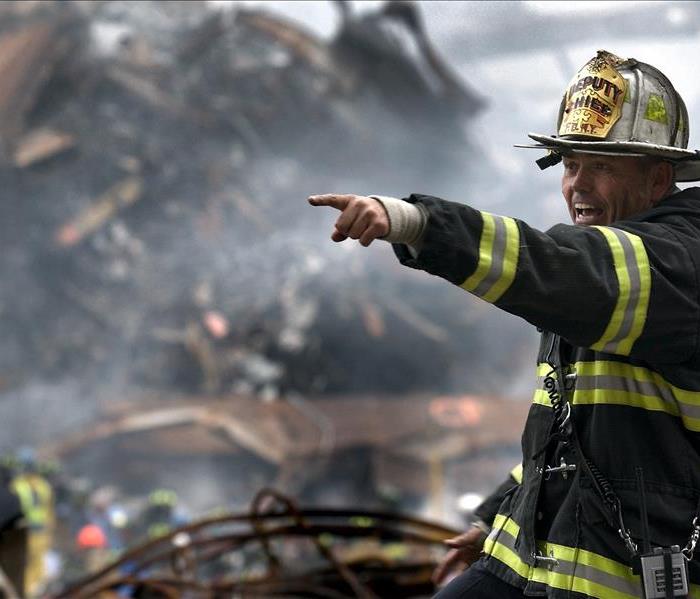 When you’re prepared for a natural disaster, you can help keep your family safe and possibly prevent damage to your home.
When you’re prepared for a natural disaster, you can help keep your family safe and possibly prevent damage to your home.
How to Prepare a Home for a Natural Disaster
In 2019, the U.S. experienced a total of 90 natural disasters, according to Statistica. Severe thunderstorm damage alone caused economic losses of $27 billion in the U.S. throughout the year. No matter where you live, you’re not immune to some type of dangerous natural disaster.
While you can’t stop a natural disaster from heading straight towards you, you can prepare yourself and your home for the event. Review this article to learn more about the effects of disasters and what preventative actions you should take to get ready for an event in your area.
Types of Natural Disasters
Before you can prepare for a natural disaster, it’s important to understand the types of events you could experience in your area. Learn more about your location and the specific natural disasters your community is prone to experiencing. Sign up for emergency text, phone call, or email alerts through FEMA, the Red Cross, or a local disaster agency in your area.
You can also review a natural disaster risk map to better understand the risks in your current environment. The Natural Center for Disaster Preparedness provides an online natural hazard risk map that allows you to learn more about the events that may occur in your area. Different hazards require different preventative measures, so it’s crucial to identify the natural disasters you may be susceptible to first.
Earthquakes
An earthquake occurs when two areas of the Earth’s tectonic plates slide past and grind against one another, causing the ground to shake. Earthquakes can occur in any state in the U.S., as long as a fault line is present. Before an earthquake, it’s important to secure large furniture and repair any cracks in your home’s walls or foundation.
Wildfire
Wildfires generally begin when wooded areas are exposed to flames from humans or lightning strikes. With dry conditions and wind, these small fires can spread and become uncontrollable, threatening nearby homes. Prepare your home for potential wildfires by clearing dry brush from around the exterior and clearing dry leaves from your rain gutters.
Flood
Floods occur when too much water is present in one area, either via rain, tsunami, hurricane, or another natural disaster. Homes and livelihoods are threatened when local waterways can’t handle the excess water. Storm flooding restoration can be extensive, depending on the damage. To prepare your home for a flood, ensure your electrical system isn’t on the ground level, and consider purchasing flood insurance.
Tornado
Severe thunderstorms cause tornadoes to form without much warning. These funnel-like clouds extend from the storm to the ground and produce powerful and damaging winds. Identify your safe room in the middle of your home and use a weather radio for updates on a tornado’s location. If you live in a mobile home, evacuate at the first signs of a tornado.
Storms and Hurricanes
While severe storms can pop up in any region, hurricanes are mainly experienced in coastal states. A hurricane may bring high wind, storm surges, and heavy rainfall but you should have plenty of warning before the storm hits your area. To prepare, board your windows, and remove or secure debris around your home.
Make a Plan
An emergency or natural disaster may induce panic and irrational thinking. However, if you have a plan in place for an emergency, you’ll be able to think more clearly and prevent or reduce damage or injury.
Emergency Action Plan
When there’s an imminent threat in your area, implement your emergency action plan. Your plan should provide an outline of the steps you need to take to prepare for the event. To create your own emergency action plan, you should:
- Know your evacuation route.
- Identify shelters in your area that meet your family’s needs.
- Have a clearly defined communication strategy with your family and neighbors.
- Learn how and when to shut off utilities to your home, if needed.
- Make an evacuation and care plan for your pets.
Disaster Recovery Plan
After a natural disaster, you may need to begin the repair and rebuilding process. Since this process can be overwhelming, it’s important to create a disaster recovery plan that includes steps to get your home back in order. This plan should include:
- Emergency contact information.
- Help and resource contact information.
- Your insurance policies and company contact information.
- Steps for cleaning your home.
- Contact information for a professional restoration company.
Depending on the disaster that occurred, you may need assistance remediating smoke and fire damage in your home. Water damage from flooding should be professionally addressed right away. If this damage isn’t repaired, you may need to hire a mold remediation specialist to clear out unhealthy mold spores from your home.
Preventative Infrastructure and Practices
Once you've identified the natural disasters that your area is prone to experiencing, implement preventive practices to prepare your property and family for these events. When you apply preventive infrastructures and practices, you can prevent damage and injury if a natural disaster occurs.
Depending on the events that are likely to occur in your area, you should consider:
- Creating retaining walls.
- Installing hurricane-resistant windows.
- Planting fire-resistant landscaping.
- Bolting down and securing heavy objects or outdoor furniture.
- Sealing cracks in your foundation.
- Removing debris from around your home.
Finances, Insurance, and Important Documents
One of the best ways to prepare for a natural disaster is to review your insurance policy. Ensure it provides coverage for the events that are likely to occur in your area. You may need to increase coverage or purchase additional policies, such as a flood insurance policy, to ensure you’re properly covered.
Create an emergency fund that you can use if a natural disaster occurs. With this fund, you can pay for unexpected expenses, such as food, shelter, or repairs that aren’t covered under your insurance. Your important documents, such as your insurance policy, identification documents, and bank account information, should be stored in a safe location and taken with you in the event of an emergency.
Build an Emergency Kit
During an emergency, you may need to evacuate your home quickly. If you stay home, you may lose power and access to a local grocery store or other conveniences.
Build an emergency kit before a disaster occurs so you’re prepared for this scenario. The items you stock in your kit should depend on your needs and the event that you think will occur but may include:
- Non-perishable food items.
- A weather radio.
- Extra batteries.
- Important documents.
- A first-aid kit.
- Supplies for children and/or pets.
Store your items in a bag or kit that’s easy to grab if you’re in a hurry to evacuate your home.
Some natural disasters are unpredictable, which is why it’s so important to prepare for emergencies ahead of time. When you create emergency action and disaster recovery plans and prepare your property for natural disasters, you can prevent severe damages and keep your family safe.
Storm Damage Experts in Winter Park
6/12/2020 (Permalink)
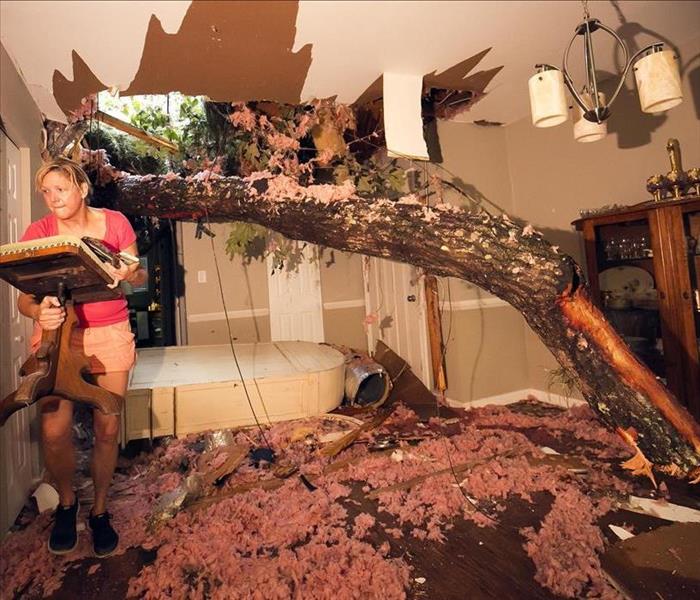 SERVPRO is ready to deal with any size storm damage. Call today!
SERVPRO is ready to deal with any size storm damage. Call today!
Quick Response and High Standards Will Leave you Satisfied after Remediation
When heavy rains and high winds hit hard, property destruction and loss can be devastating to you as a homeowner. Structural damage to the exterior of your home is followed by interior devastation from water and winds. Storm damage is rarely isolated to just a few buildings in an area adding the challenge of finding a restoration company that can respond swiftly to your needs to an already anxiety-provoking situation. SERVPRO delivers the help you need swiftly even when a local disaster is widespread as we are able to call upon a network of over 1,650 franchises nationwide to respond if the need is great.
Storm damage in Orlando can feel overwhelming, but your fear and panic will disappear when our team of professionals responds to your water, wind, and flooding repair and restoration needs. Your particular situation is of paramount importance to us, and you need not worry that your repairs and restoration will take a back seat even when many in your area are struggling to recover from the same issues you face. Choosing our company puts in motion a vast support system, but our local ownership means you will receive a personalized approach to your particular situation, efficiently returning your home back to its pre-storm condition just “Like it never even happened.”
Placing your trust in SERVPRO for your storm damage needs will reap you benefits that less qualified companies simply cannot deliver. We use state of the art equipment to clean, repair, and restore your home and in the process, we also restore your and your family’s peace of mind. Our technicians are highly trained and qualified, current in the Institute of Inspection Cleaning and Restoration Certification (IICRC) for any procedure needed to bring your home back to the comfortable and comforting refuge you deserve. We also work closely with your insurance company, ensuring that all the work necessary is approved and compensated according to the terms of your policy. Our high standards and relentless drive to do the job on time while meeting local specifications means you and your family will quickly return to the quiet enjoyment of your house and neighborhood. We are not satisfied until you are happily back in your restored dwelling.
Once you make sure that your family is safe after a major storm, your first call should be to SERVPRO of Winter Park. Dial (407) 678-5391 24/7 and begin the road to recovery by scheduling an inspection with our storm damage experts.
Tropical Storms Can Damage Your Home
5/20/2020 (Permalink)
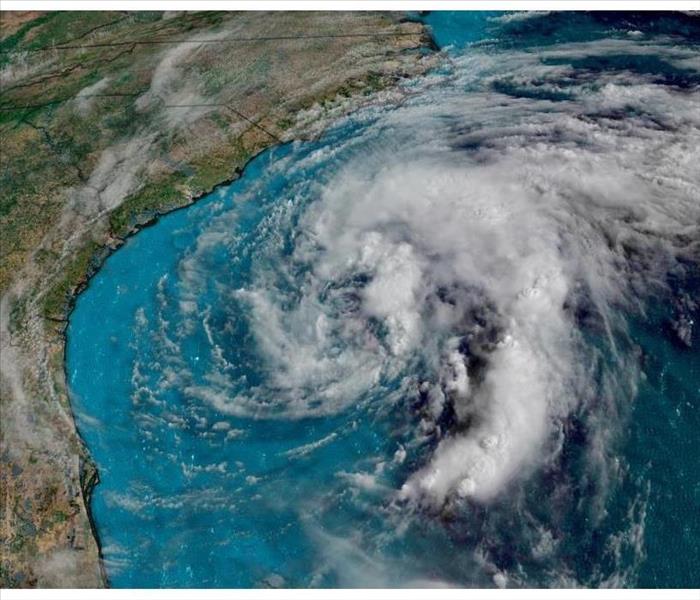 Strong winds from Tropical Storms can damage your home.
Strong winds from Tropical Storms can damage your home.
Damages from Tropical Storms
Tropical storms carry winds from 39 to 73 mph. They can also spawn destructive tornadoes. When wind speeds are lower, then storms are labeled tropical depressions. When wind speeds are over 73 mph, then they are called hurricanes, typhoons, or cyclones, depending on where they form. The biggest danger in a tropical storm front is its massive rainfall, causing severe flooding. The winds from tropical storms often lessen as they cross over land because the storms need warm water for fuel. However, they can continue to cause damage as they move inland. Tropical storms slow down as they move over cooler ocean waters.
Tropical storms now carry names like hurricanes and other damaging weather conditions. In the early 1900's, an Australian weatherman began naming their damaging tropical storms after people he did not like. In 1953, the U.S. also started naming tropical storms after women. Since 1979, both male and female names have been used by the World Meteorological Organization. In other parts of the world, like Asia, tropical storms are named for flowers, animals, people, and other things. In the U.S., there are no storms that start with Q, U, X, Y, or Z. If storms outnumber names, then they are named after letters of the Greek alphabet, such as Alpha or Beta.
It does not make any difference if damage to your home or business occurs from a tropical storm or a hurricane. Damages are usually the same for lives and properties. Even though a hurricane produces heavier rains, winds, and flooding, a building is still subjected to substantial damage. A tropical storm's damages include wind, rain, storm surge, mud, debris, etc. Every insurance policy is different, therefore, if you are not sure what types of damages are covered under your plan, speak with your insurance agent to make sure that you have coverage for damages that a tropical storm can cause.
When your home or business is gravely affected by a tropical storm, call us, your trusted leader in restorations and repairs – SERVPRO of Winter Park! We make our customers, our primary concern so that getting your lives and property back to its pre-damaged state is less stressful. After a tropical storm, you need help right away. Since we are near your community, we offer immediate response times. Our Disaster Recovery teams of certified experts are available 24 hours a day, seven days a week. We will also help you with processing claims to your insurance company. All of our skilled workers will perform to your complete satisfaction!
2020 Hurricane Season Safety Tips
5/1/2020 (Permalink)
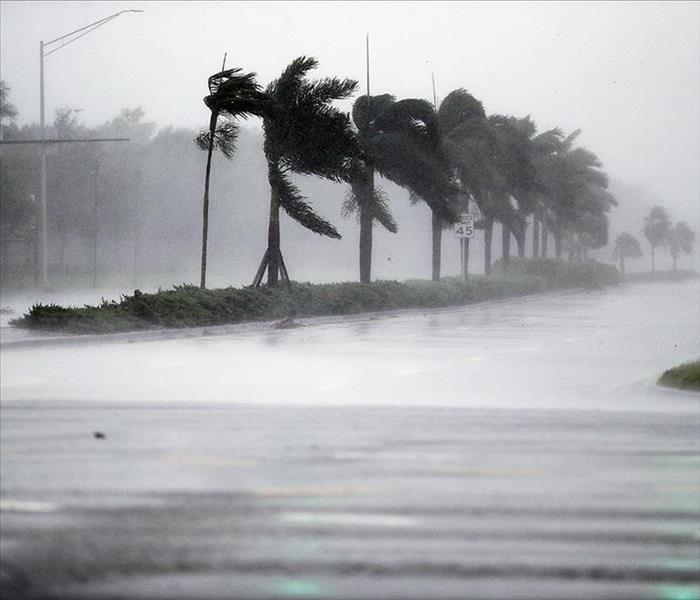 The 2020 Hurricane Season is predicted to have stronger hurricanes than is typical making it important for Florida residents to put safety first
The 2020 Hurricane Season is predicted to have stronger hurricanes than is typical making it important for Florida residents to put safety first
Hurricanes can be terrifying. Even a minor storm often leads to a trail of destruction stretching for miles once the storm passes. While hurricanes are dangerous, the good news is that it is possible to prepare for them. As hurricane season creeps up, hurricane safety needs to be a priority. All those living in hurricane-prone areas should and must make hurricane safety one of their primary concerns. The good news is that it is possible to mitigate the worst effects of any storm. Advanced preparation and careful attention to detail are the keys to coping with any hurricane season.
Evacuation Plans
In many instances, it is apparent where a hurricane is headed. Weather forecasters can often see the potential path of any hurricane at least several days in advance. Now is the time to think about what is going to happen should you be in the path of that storm. It's a good idea to look for local resources. Many communities are well aware of the possibility that hurricane season may have a huge impact on their area. They take advance steps to ensure that all residents have a safe place to stay or a way out no matter the strength of the storm.
For those with special needs, hurricane safety is especially important. Seniors may need medications as well as wheelchair accessible shelters. If you have a baby, they may need a formula or a safe area to prepare it. This goes true for other supplies. A supply of diapers and changes of clothing should ideally be readily available. Pets also need special care during a storm. Some shelters want to make sure people with allergies can come there so they don't allow any pets. Find out which shelters nearby let you bring your pets with you so they can stay safe.
Food and Supplies
Food and other supplies may be at a premium in the period before, during, and after the storm. As the season begins, now is the time to create a list of things you're likely to need. If you're taking daily medications, you need to know where they are and make sure you have at least a week's supply on hand. Create a bag with your supplies in easy reach. If you're staying, you should have food that won't spoil and water that is safe to drink. Items that don't need to be refrigerated like nuts and snack foods can fit in nicely in any packed bag.
Other items should also be in easy reach. Power may be off temporarily for an extended period. Flashlights with plenty of spare batteries are essential. Make sure you know where they are before the storm season starts. Banks can be out of cash. Credit card machines may not be working. Keep a certain amount of cash in a safe and easy to reach the place before the season begins. A cell phone is also a must. Chargers should be available so you can use them at home and on the road.
Insurance Policies
Many people carry insurance against hurricane damage. Know what those policies cover before the season starts. You may need to access your policy number. Keep insurance policies and other important documents with you or nearby. It's a good idea to examine all of your rooms before the season starts. Take detailed pictures of your belongings. This way, once the storm hits, you'll have the documentation you need to prove to your insurance company exactly what was lost. Detailed personal records can also help you get things back as you want once the storm is done.
How Coronavirus Can Affect the 2020 Hurricane Season in Florida
4/22/2020 (Permalink)
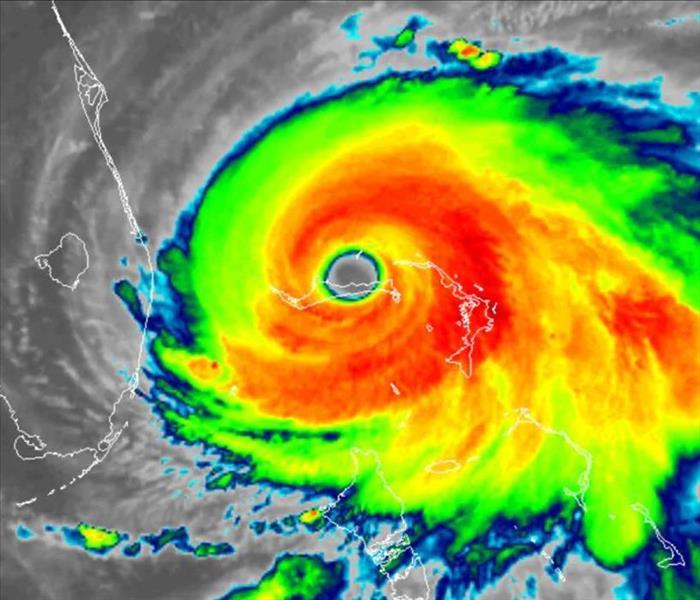 2020 hurricane predictions are showing a potential increase in activity this season
2020 hurricane predictions are showing a potential increase in activity this season
Hurricanes are a fact of life. In the southeast, people have learned to prepare for hurricane season. Hurricanes typically strike this part of the country between June 1st and November 1st. During this time, people can expect more hurricanes to strike the coast and head inland. This year, hurricane season poses a particular challenge. In the face of the ongoing COVID-19 pandemic, people from all walks of life are wondering exactly how to respond. Weathermen, epidemiologists, and all those involved in speaking to the public are trying to figure out the best way to proceed as they head into this season.
The Impact of COVID-19 on Hurricane Season
One thing is for certain. The Coronavirus has already had an impact on the way people think about the summer and the impact that hurricanes will undoubtedly have on travel plans and for residents of places that are highly affected by these storms. As March falls into April, this is when many people in Florida start to hear messages about what they should do to make plans. Instead of working towards a comprehensive plan to cope with expected issues related to hurricanes, officials have focused their attention largely on efforts related to the Coronavirus crisis. Two hugely important conferences related to early preparations, the Florida Governor’s Hurricane Conference, and the National Hurricane Conference have actually been canceled. In doing so, first responders and other officials have lost out on opportunities to learn about new developments that might make for more efficient responses based on recent data.
Several Plans Are in Place
Florida is going to be hit hard by COVID-19. Officials do not expect to hit peak until early May. Thirty-six deaths are expected daily when hurricane season hits. In addition, it is also possible that the region may experience later waves of infections in the fall. As that is the height of the season when storms are traditionally at their strongest, it is clear that officials must figure out new ways to ensure that all those are safe even when a storm is about to make landfall.
With that goal in mind, certain guidelines are being developed by experts. One question becomes if those who are infected with the virus should be sent to separate shelters. Guidelines in place already limit how many people can be in one place at one time right now. Local governments may need to create more shelters and spread them out further in order to keep people safe from the virus and from the hurricane at the same time.
Some people have special medical needs. They may need to have room for attendants on hand who can assist them with basic tasks in the middle of a hurricane. Those who are suffering as a result of the virus will need to be moved carefully if a medical center is threatened with a massive storm. Given the issues with the pandemic, it is also likely that even those who are healthy may be worried about moving into a shelter for fear of being infected.
An Active Season
Weather forecasters believe the coming year will probably be an active season for hurricanes. This means a busy season when at least several hurricanes will head to land. Floridians need to take special care from August to October. Certain areas are especially vulnerable. Areas such as the Keys are dependent on tourism for much of their income. That leads to increased unemployment and decreased funding for locals. Other areas along the coast are also hard hit because of prior issues such as heavy rainfall. The question becomes if officials at health and other organizations can cope with the new problems.
While this is all scary for many locals and public officials, those at FEMA are confident they have what it takes to manage a pandemic and any hurricane at the same time. Other officials are also hopeful the worst of the pandemic will pass them by before the really bad hurricanes begin. They believe that deaths and infections will likely begin to taper off by that time. They also believe they have the financial resources to cope with it all. It is clear that procedures are in place to combat the storms and the pandemic.
Tropical Storm Dorian Gaining Power
8/27/2019 (Permalink)
The latest Tropical Storm Dorian update from the National Hurricane Center features some potentially encouraging news for Floridians.
A still-uncertain long-term track showed the storm near Florida over the weekend, but Hurricane Hunters couldn't find a clear center during their latest flight due to the storm moving across St. Lucia. That disruption and dry air have kept Dorian from intensifying.
The storm's effects are expected to be felt in Puerto Rico by Wednesday afternoon and travel up to Hispaniola that night. Forecasters say Dorian will then head toward the Bahamas Friday and Saturday and reach southeastern Florida by early Sunday.
While uncertainty is high, Florida residents should monitor the progress of Dorian and ensure that they have their hurricane plan in place.
There was a slight adjustment north in the forecast cone Monday night to include Orlando and Daytona Beach. The cone was also tightened up to cross the eastern side of Hispaniola, meaning it is less likely now that the mountains will have a chance to significantly weaken Dorian.
If the storm goes across the Dominican Republic and Haiti, the mountains might weaken it, but if it stays over the ocean, weather officials believe the storm could gain strength as it travels towards Florida.
The U.S. National Hurricane Center said that as of 11 a.m. Tuesday the storm has maximum sustained winds near 50 miles per hour and is forecast to strengthen during the next 48 hours before hitting the U.S. territory. It is currently 60 miles west-northwest of St. Lucia.
We're in the peak of hurricane season
Dorian is the fourth named storm of this hurricane season. Generally, the season reaches a peak in the eight weeks surrounding September 10.
Two-thirds of all the storms produced in a typical season occur during this period.
That's because conditions in the tropics become ideal for storm development. By the end of August, water has typically warmed to the mid-80s in many parts of the region.
Storm Tips 2019
8/21/2019 (Permalink)
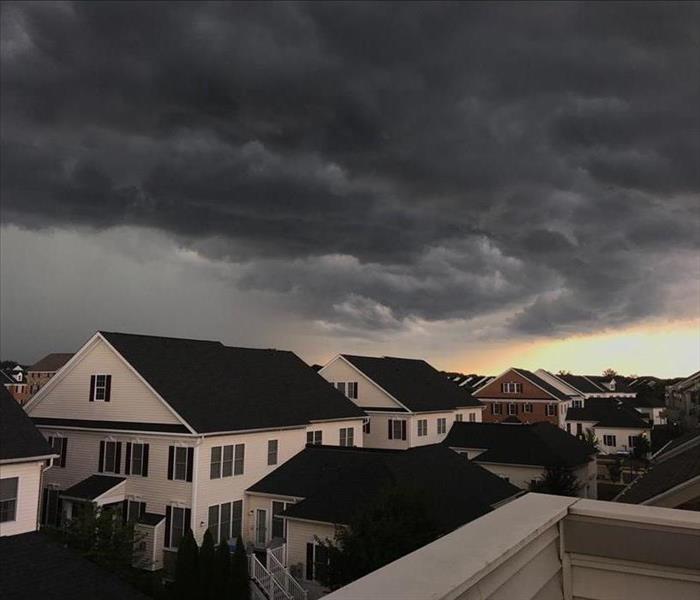 Nail down roof shingles or use adequate adhesive to keep them from blowing off in a violent wind.
Nail down roof shingles or use adequate adhesive to keep them from blowing off in a violent wind.
No matter where you live, you'll encounter storms. Most of the time these are routine, but some cause serious and dangerous problems. Here are tips for preparing for storms, and weathering them safely.
- Always keep a battery-powered radio in your home so that you can tune to radio stations if you lose electricity. Check or change the batteries frequently.
- Keep a flashlight in an easily accessible spot on every floor of your home. Check the batteries monthly, and replace them as needed.
- Keep a supply of candles on hand for power failures.
- As a safety precaution before leaving the house on vacation, unplug all electrical appliances except for those lights connected to automatic timers.
- If you live in a storm-prone area, nail down roof shingles or use adequate adhesive to keep them from blowing off in a violent wind. For roofs with shingles that are not the seal-down type, apply a little dab of roofing cement under each tab.
- A lightning-protection system should offer an easy, direct path for the bolt to follow into the ground and thus prevent injury or damage. Grounding rods (at least two for a house) should be placed at opposite corners of the house.
- Don't go out during a hurricane unless you have to; however, if flooding threatens, seek high ground, and follow the instructions of civil defense personnel.
- When a major storm is imminent, close shutters, board windows, or tape the inside of larger panes with an "X" along the full length of their diagonals. Even a light material like masking tape may give the glass the extra margin of strength it needs to resist cracking.
- When a tornado threatens, leave windows slightly ajar.
- The basement is not good shelter during a tornado -- it's too close to gas pipes, sewer pipes, drains, and cesspools. A better shelter would be underground, far from the house (in case the roof falls) and away from the gas and sewer systems. Let all family members know where the shelter is.
- Keep an eye on large trees -- even healthy ones -- that could damage your house if felled in a storm. Cut them back, if necessary.
We've covered numerous key tips for preparing for storms and getting through them safely. Now you can regard gathering clouds with a little less trepidation.
Avoiding Hurricane Insurance Scams in 2019
6/10/2019 (Permalink)
 Scams have become more frequent with each passing year and present an additional possibility for a disaster following a hurricane.
Scams have become more frequent with each passing year and present an additional possibility for a disaster following a hurricane.
Hurricane season always brings the potential for significant property damage, which is often covered under homeowner's insurance policies. Unfortunately, the insurance industry as a whole collects more than $1 trillion a year in premiums, which makes it a prime target for a wide range of fraud, including hurricane scams. While homeowners themselves may be innocent of any wrongdoing, they can also become the unwitting victims of insurance fraud or even unwitting participants. Insurance fraud costs the average American family anywhere from $500 to $700 per year in added premiums. Here are four ways to protect yourself from hurricane scams during the 2019 Atlantic Hurricane Season.
1. Be Wary of Anyone Knocking On Your Door Offering Unsolicited Repairs
For the most part, reputable contractors and repair services will more than have their hands full in the wake of a hurricane. In fact, the long waiting list for estimates and repairs is what creates a prime environment for scam artists. While reputable companies may send out door knockers offering estimates, they will never perform repairs right there on-the-spot.
2. Always Get at Least Three Estimates
You will want to get at least three estimates before deciding on a contractor and check each one carefully to see what work they are recommending. In some cases, unscrupulous contractors may charge for services that should be free and in other cases, they may try and charge for work that doesn't actually need to be performed. When you get estimates, you don't want to just look at the price but also at all the work recommended. If an estimate recommends significantly more or less work than the others, that might be a red flag. In the case of too little work, they may try and bill you more for additional work later and in the case of too much work, they may charge you for services they don't actually perform.
3. Check the Contractor's Credentials Carefully
Any natural disaster brings a flood of impostor contractors, so be sure and check their credentials carefully. In some cases, reputable contractors may come in from nearby areas to help cover the overflow of work, but you should still be able to check their credentials, no matter where they come from. Most states require contractors to carry worker's compensation, property damage, and liability insurance and may even need to be licensed. Ask for a copy of their license and insurance and then contact your local or state licensing agencies to ensure their credentials are in good standing and they meet all the requirements. You will also want to contact their insurance company to ensure their insurance is in good standing and their policy has not lapsed. Last, but not least, you will want to check with reputable agencies like the Better Business Bureau or Angie's List. Your insurance company may even be able to recommend a number of pre-vetted contractors.
4. Get a Clear, Written Contract and Read It Carefully
Before the contractor begins work, you need to ensure you have a clear, written, detailed contract that clearly defines everything the contractor is being contracted to do. This should include prices for labor, materials, clean-up procedures and estimated start and finish dates. Also, make sure there are no blank spaces on the contract that can be filled in at a later date and that you read the contract carefully before signing. One of the biggest scams plaguing the insurance industry is Assignment of Benefit or AOB scams. This is when the homeowner simply signs away their benefits, leaving any negotiations between the contractor and the insurance company. While this may seem like a good deal and alleviate a lot of paperwork, in truth, it opens homeowners up to repairs not being completed and insurance companies being billed for services never performed.
Lightning Safety: What You Need to Know
5/13/2019 (Permalink)
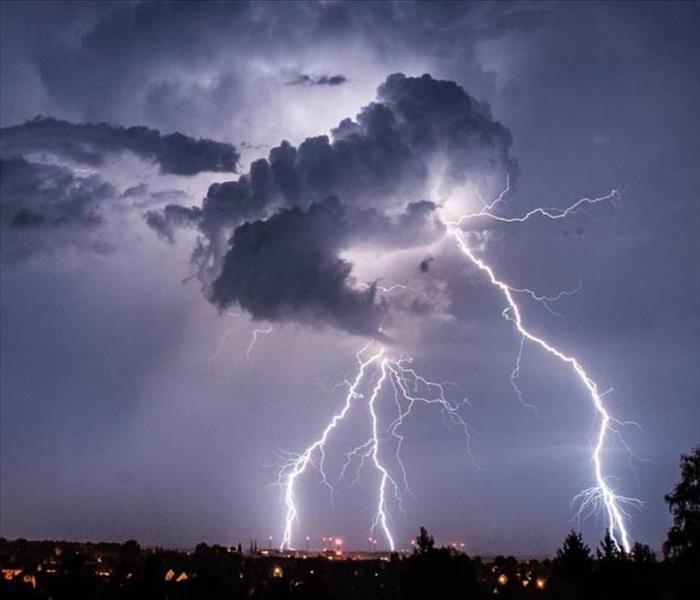 Tall thunderstorm clouds are more likely to produce lightning strikes.
Tall thunderstorm clouds are more likely to produce lightning strikes.
The chances of being killed or injured by lightning are slim to none. However, that does not mean it can’t happen or that you should not exercise caution during a storm. The most important tip for being safe during a lightning strike is actually quite simple. Avoid being in the wrong place at the wrong time. Lightning is generated on a scale that is too large to be influenced by small objects on the ground, so if you are struck by lightning it is because you were in the spot that the lightning was already going to strike. Victims of lightning strikes in the past were struck regardless of the metal items that were or were not around them at the time.
Instead of thinking about the items that are around you, you would be better suited to focus on where you are. Avoid the areas where lightning can strike which is, essentially, anywhere outdoors.
Stay Indoors
Staying indoors during a storm is the number one way to keep safe from a lightning strike. If lightning strikes a house or a building directly, it will tend to follow the available paths to ground, including the electrical wiring, plumbing, cable or telephone lines, antennas and/or steel framework. Structures like bus shelters, outhouses, lean-to shelters, or any small non-metal structure do not provide any lightning protection. Although most homes serve as a safe shelter from lightning strikes there are still safety measures you can take inside to minimize danger such as:
- Don't use any wired appliance or device. Wireless appliances (cordless phones, razors, etc) are safe to use.
- Stay away from water pipes and faucets. (No baths, showers, etc.)
- Don't stand on a basement floor or patio slab, or anywhere where standing water or excessive moisture is present. These areas are 'ground current' danger zones.
- Stay away from walls where electrical wiring is present. Lightning will occasionally jump through the air inside a house or building to reach a better grounding path, such as from electrical wires to a water pipe.
Go to Your Car
If there is no other option for shelter, you are safer in your vehicle than out in the open. This is only true for hard-topped vehicles and does not apply to convertibles or open vehicles such as golf carts. While inside the vehicle keep your windows closed and make sure to avoid touching metal parts of the car. The current from a direct hit from a lightning strike will usually travel through the frame of the car and through the tires before hitting the ground. After a strike, make sure to check the vehicle to make sure fuel was not ignited which can lead to an explosion.
Does Clothing Matter?
Clothing and accessories you are wearing do not influence your chances of being struck by lightning. That being said, if you are struck, metal items you wear can act as conductors for the electrical current. These items can become vaporized, leaving burn marks on your body.
Lightning Warning Signs
In addition to the obvious warning of an ominously darkening sky, there are certain conditions that can alert you to a lightning danger before the strikes threaten. You are in a 'danger zone' and need to seek immediate shelter if you experience any of the following:
- Rain and hail can signal the presence of a thunderstorm cloud overhead especially if the rain is heavy. In fact, larger raindrops can occur when a thunderstorm cloud is tall and more likely to produce a lightning strike.
- If you can hear thunder or see flashes from lightning strikes, you are in the range of the next strike.
- AM Radio static, crackling, and popping noises can occur when lightning strikes are present.
- Doppler weather radar will show thunderstorms as red, orange and/or yellow blobs. There are many resources online that you can utilize to see this radar including mobile applications. The Weather Channel also shows Doppler radar periodically.
Early Predictions for 2019 Hurricane Season
5/1/2019 (Permalink)
 Early hurricane season predictions help us know what to expect, however, we should always prepare for the worse as they have been wrong in the past.
Early hurricane season predictions help us know what to expect, however, we should always prepare for the worse as they have been wrong in the past.
Even though the severe weather from last year's tropical season only ended four months ago, it is just another month until the upcoming 2019 Atlantic hurricane season kicks off on June 1st. The season extends through November 30th, with approximately 95 percent of all the major storms happening after August 1st in the so-called peak season. Earlier in April, Colorado State University's highly respected hurricane predictions research team unveiled its early tropical predictions for 2019. With more than 35 years under their belts, this year they are calling for a slightly less active than usual hurricane season.
Early Hurricane Predictions For 2019 Hurricanes Season
Colorado State University is predicting for 2019 hurricanes 13 named storms, with five of them becoming hurricanes and two evolving into major hurricanes. This is close to the usual quantity of predicted storms. The good news is that overall tropical activity (measured based on the storms' intensity and total energy rather than the number of named storms) has been forecast at a little below the average season. In the typical tropical season, there are 12 named storms, 6 hurricanes, and 3 major hurricanes sweeping through the Atlantic Ocean or the Caribbean Sea.
How These Predictions Are Made and Compare to the 2018 Season
The Colorado State University team contemplates the present day state of El Nino and the Atlantic Ocean temperatures in coming up with its highly anticipated tropical outlook. The two important elements are showing the season will be less active than usual.
In 2018's tropical season, the number of storms proved to be 15 named, 8 hurricanes, and 2 major hurricanes. The two major storms were Hurricanes Michael and Florence. Hurricane Michael landed in Mexico Beach, Florida with stunning total winds of 155 miles per hour on October 10th at almost Category 5 power. This proved to be among the most potent hurricanes to ever make landfall in the United States. For its central barometric pressure, this was the third most powerful storm in history to land in the U.S. No landfalling storm since Hurricane Andrew (smashing into south Florida in August of 1992 and leveling everything in its landing) boasted the winds of Michael. Michael's economic impact is estimated by economists to run $25 billion.
Hurricane Florence landed in North and South Carolina back in September of 2018. The storm poured out over 30 inches worth of rain, causing severe flooding for many days. Over a dozen individual rivers reached major flood levels, causing forced evacuations and devastating property damage. Both Hurricanes Matthew (2016) and Floyd (1999) had their flood records destroyed by Florence. It caused an estimated approximately $25 billion in damage as well.
Colorado State University's team is not the only one making hurricane season forecasts. AccuWeather the private service has predicted a greater number of storms for the season, with from five to seven full hurricanes. AccuWeather was quick to remind that seasons with fewer storms than average have still produced devastating hurricanes.
Predictions Have Sometimes Been Far Off In The Past
In the last several years, the initial forecasts from Colorado State University have been pretty accurate. In 2018 they called for seven hurricanes and eight occurred. For 2016, they predicted six when seven hurricanes actually formed.
Yet they missed the outcome of season 2017 pretty significantly, as did the other hurricane forecasting outfits. While they predicted four hurricanes in 2017, the season produced 10. Among these were the hugely destructive Irma, Harvey, and Maria. This once again goes to show you that even a low number of predicted hurricanes for a season can still lead to hugely destructive hurricanes in the end. Because of this possibility, it is always important to prepare for a hurricane regardless of early predictions.
2019 Atlantic Hurricane Season Tips
4/5/2019 (Permalink)
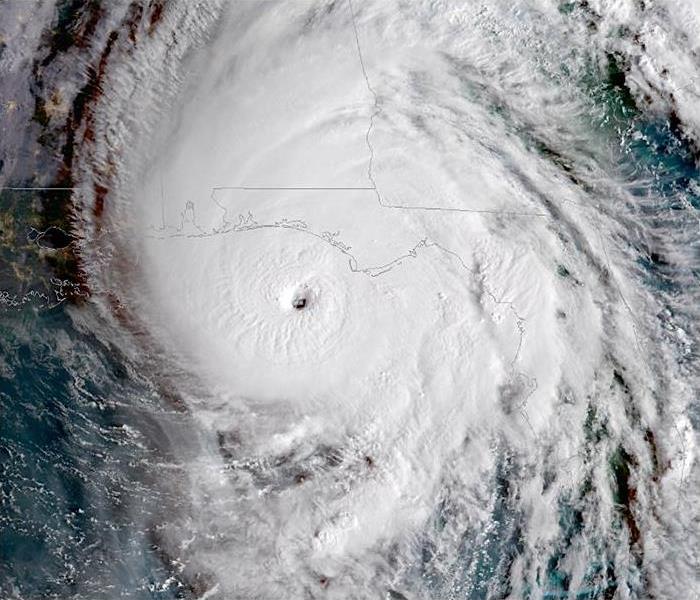 Florida has a long history of dealing with hurricane seasons. Make sure you are prepared over the next 2 months before the 2019 season begins!
Florida has a long history of dealing with hurricane seasons. Make sure you are prepared over the next 2 months before the 2019 season begins!
The 2019 Atlantic hurricane season begins in just two months. Many Floridians are already accustomed to what that means and the possible dangers that come along with it while others may be newer to Florida. Whether you are accustomed to hurricane seasons or not, being a resident in Florida means that the threat of hurricanes is very real and having the knowledge of what to do before, during, and after a storm can make all the difference. Stopping a tropical storm or hurricane from happening is not an option. However, taking the appropriate steps to make sure you and your family are both safe and prepared in the event of a hurricane is. Below are a few helpful tips and reminders for the upcoming season.
Preparations Before A Storm
Emergency Supplies
- Emergency water supply
- Have at least 5 gallons of water per person (which should be enough to last 3 to 5 days)
- Gather clean containers for water.
- Get supplies to make your drinking water safe (like iodine tablets or chlorine bleach).
- Emergency food and medicine supply
- Put together a 3 to 5 day supply of food that doesn’t go bad (like canned food)
- Make sure to have enough baby food or formula (if needed).
- Gather any prescription medicines.
- Safety items
- First aid kit and instructions
- Fire extinguisher
- Battery-powered radio
- Flashlights
- Extra batteries
- Sleeping bags or extra blankets
- Personal care products
- Hand sanitizer
- Wet cleaning cloths (like baby wipes) in case you don’t have clean water
- Soap
- Toothpaste
- Tampons and pads
- Diapers
Disaster Plan
- Write down emergency phone numbers and keep them near every phone in your house or on the refrigerator. Program them into your cell phone, too.
- Buy a fire extinguisher and make sure your family knows where to find it and how to use it.
- Find out where the nearest shelter is and the different routes you can take to get there if you have to leave your home.
- Make sure that everyone in your family knows what the warning sirens in your area sound like and what to do if they go off.
Damage Prevention
Stock up on materials to help prevent unnecessary damage to your home in the event of a hurricane. Have tools and wood ready to board up windows. You can also purchase sandbags to block water from coming in via entrances such as doorways and garage doors.
If you can afford to, have a roof inspection done and repair any old or broken materials to help prevent against water entry. Also, make sure all rain gutters are cleaned out to allow water to flow away from your property as intended.
For more tips click here
Property Insurance
Get familiar with your current homeowner’s policy and make sure you understand what you are and what you are not covered for if a storm damages your home. Add any additional coverage for flooding to save yourself from having to come out of pocket completely if the worst happens.
What to Do During A Storm
Put your plan into action. The most important thing to understand is that the safety of you and your family is always the priority and any decisions made should reflect that. If you have properly prepared, stay indoors and wait out the storm. If you do not feel you are completely prepared to do so, head to the nearest shelter with plenty of time to spare before the hurricane approaches your area.
Additionally:
- Use a portable radio to listen to important storm updates, information and instructions.
- Stay inside and keep away from all windows, skylights and glass doors. Go to a safe area, such as an interior room, closet or downstairs bathroom.
- Never go outside the protection of your home or shelter before there is confirmation that the storm has passed the area. The eye of the storm could create a temporary and deceptive lull, with high winds still approaching.
- If power is lost, keep the refrigerator closed to keep cold air trapped and delay spoilage of perishable food.
- If you use a portable generator, follow all the manufacturer’s instructions. Generators should be properly grounded to prevent electrical shock and should never be operated indoors, in garages, basements or outdoors near any windows, doors or vents. Because generators produce carbon monoxide (CO), make sure you have a working CO detector in your home.
What to Do After A Storm
Insurance
If you have sustained damage to your property, file a claim as quickly as possible. Insurance companies will be overwhelmed with calls of damage so the sooner you can file a claim, the sooner you can expect compensation. Make sure to document any damage as thoroughly as possible to speed up the process for your insurance adjuster and the entire process overall.
Property Damage
After filing a claim, working with a trusted restoration company is best for getting your property back to pre-hurricane conditions. A national brand such as SERVPRO has the manpower and equipment to remove large amounts of water from your home, dry out affected structures quickly, repair and restore property damage, and even remediate mold if it becomes an issue in your property.
Safety Tips Include:
- Stay tuned to local news organizations, such as a radio or television station, for important announcements, bulletin, and instructions concerning the storm area, medical aid and other forms of assistance, such as food, water, and shelter.
- Remember that you may not have immediate access to your home. Emergency rescue crews, power crews, and other personnel may be attending to special needs. Roads could be blocked, power lines could be down and people may be trapped and in need of assistance.
- Make sure that you have current identification. You may have to pass through identification checkpoints before being allowed access to your home/neighborhood.
- Avoid driving as roads may be blocked.
- Avoid sight-seeing or entering a storm-ravaged area unnecessarily. You could be mistaken for a looter.
- Avoid downed power lines even if they look harmless.
- Avoid metal fences and other metal objects near downed lines.
- DO NOT use matches in a storm-ravaged area until all gas lines are checked for leaks (keep flashlights and plenty of batteries at hand).
- Avoid turning the power on at your home if there is flooding present. Have a professional conduct a thorough inspection first.
- Consider having professionals/licensed contractors inspect your home for damage and help in repairs. This includes electricians, as well as professionals to inspect gas lines, remove uprooted trees and check the plumbing.
- Remember that downed or damaged trees can contain power lines that can be a hazard.
- Use a camera or camcorder to record thoroughly any damage done to your home before any repairs are attempted.
- In certain areas, the flooding rains that accompany a storm can create pest problems. Be aware of potential pest problems in your area, such as mice, rats, insects or snakes that may have "come with the storm".
- Telephone lines will likely be busy in the area; use a phone only for emergencies.
- Flooding brings with it the risk of waterborne bacterial contaminations.
- You should assume that the water is not safe and use properly stored water or boil your tap water.
6 Things Your Flood Insurance Will Not Cover
8/28/2018 (Permalink)
 Floods are stressful disasters to deal with. Knowing what your policy does and does not cover will help you be prepared and know what to expect.
Floods are stressful disasters to deal with. Knowing what your policy does and does not cover will help you be prepared and know what to expect.
Flood Insurance Does Not Cover Everything
Flood insurance is extremely important when trying to make sure you are prepared for a worst-case scenario during a large storm or hurricane. While this type of coverage is worth looking into, it is important to know that there are types of damage that are actually not covered by your policy so you are not blindsided if you ever need to make a claim. Knowing the key restrictions and limitations of your flood insurance policy will leave you better prepared.
1. Water Damage from Internal Malfunctions
A flood that is caused by internal malfunctions in your home such as a pipe burst or overflowing toilets is not covered by a flood policy. Damage will only be covered if the source of water that caused the flood is external, such as an overflowing lake or heavy rain during a storm. Make sure that you are covered for floods from internal malfunctions by having a homeowner’s insurance policy as well. Talk to an agent or adjuster from your insurance policy for more information and questions about the kind of water damage your policy will cover.
2. Landscaping and Swimming Pools
Although your swimming pool may be located outside of your actual home, if your home is flooded by your pool it will not be covered by your flood insurance policy. Also, damage to flower beds, gardens, trees, or any other landscaping on your property will not be covered.
3. Damage from Small Floods
Unless the water that causes damage to your property covers at least two acres or has also affected another property, the water will not be considered a flood by your insurance company. Also, if your home sustains damage from mold or mildew that could have been prevented, you will not be covered for the damage under your policy.
4. Living Expenses and Business Interruption
Any living expenses that you incur from the flood, such as renting a hotel room, will not be covered by your flood insurance policy. Also, if you run a home business and your operations are interrupted, financial losses will not be covered.
5. Money and Important Papers
Your policy won't pay for the value of any currency, precious metals, stock certificates, and other valuable papers that get destroyed in a flood.
6. Improvements and Most Contents in Below-Ground Areas
You will not be covered under your flood insurance policy for any improvements made to your basement, such as finished walls or floors. Also, personal property such as clothing, computers and electronic equipment, kitchen and office supplies, furniture, and other items located in your basement or any other areas below the lowest elevated floor of your home will not be covered.
Flood Insurance Policies for Florida Homeowners
8/22/2018 (Permalink)
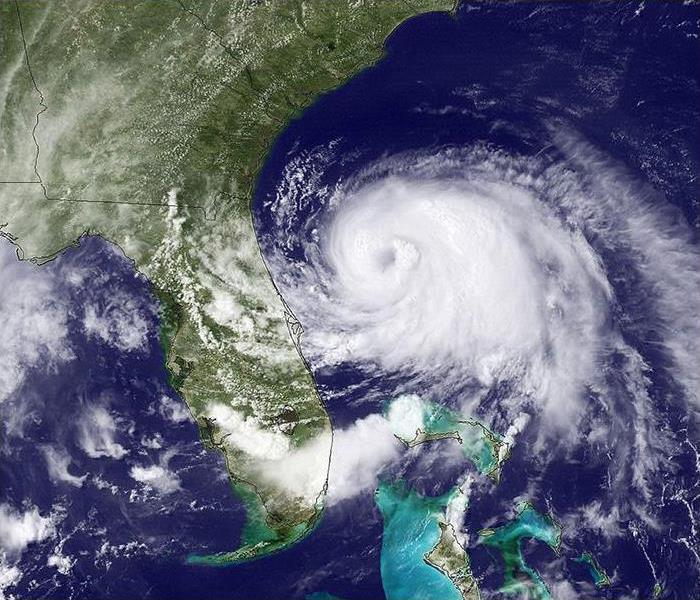 Make sure to get a flood insurance policy 30 days or more prior to hurricanes to ensure that damage is covered!
Make sure to get a flood insurance policy 30 days or more prior to hurricanes to ensure that damage is covered!
A common mistake that many Florida homeowners make each hurricane season is the assumption that their homeowner’s insurance will cover property damage that is caused by floods and hurricanes. If your property is in an area with a high risk for damage, such as near a lake, then you may want to consider purchasing a separate policy to make sure your home and its contents are covered.
How Do You Get Flood Insurance?
Flood insurance is managed by the Federal Emergency Management Agency (FEMA) but can be purchased through your insurance agent or broker through the National Flood Insurance Program (NFIP). Availability for these policies is open to NFIP-participating communities that have agreed to pass and enforce specific stormwater and floodplain management laws. To reach an agent, contact the NFIP at 888-379-9531.
How Much Coverage Can You Get?
NFIP flood insurance policies can provide a maximum coverage of $250,000 and $100,000 for contents. These types of coverage must be purchased individually but can be a part of the same policy. According to the NFIP, the average cost for a policy typically runs around $700 annually. Additional coverage may also be purchased through private insurers.
Do You Really Need this Policy?
When purchasing a home in a designated high-risk flood zone and receiving a mortgage loan from a federally regulated or insured lender, you are required to purchase flood insurance.
If you live in a zone that has been designated as a moderate or low-risk flood zone, you are not required to purchase a policy. However, though you are not required to purchase the policy, you may want to consider doing so anyway to protect yourself from paying out of pocket in case of an emergency. According to FEMA, approximately twenty-five percent of flood insurance claims come from areas. That still makes up a large portion of recorded home damage due to hurricane and flood-related disasters!
The good news is that if you do live in a low-to-moderate flood risk zone, you may be eligible for a much lower insurance rate. Some premiums of flood insurance policies for these homeowners have been seen to be as low as $137 per year for both property and contents coverage.
Are Payouts for Contents and Property Different?
Yes, there is a difference in the way insurance companies will pay out for different types of coverage.
- Contents - Flood insurance will pay a cash value for the cost to replace lost or damaged contents. The amount paid out also factors in the depreciated value of used goods.
- Property - If receiving insurance for a single-family home as your primary residence, you can opt for the replacement of damaged or lost property with new property, regardless of depreciation. The amount of coverage for your property is set in advance and is typically either eighty percent of the full replacement cost for your property or the maximum amount available under the NFIP.
Why You Should Act Now
Flood insurance works a bit differently than other types of insurance policies. With a few exceptions, your coverage does not typically kick in until you have had your active policy for 30 days. If a disaster, such as a hurricane, occurs within this time frame, your insurance policy will not cover the costs of damage.
Also, there are other benefits to activating your policy early. Aside from hurricane damage, a flood insurance policy will also cover you for damage resulting from heavy or prolonged rainstorms, coastal storm surges, clogged storm drainage systems, and mudslides!
After Receiving Flood or Hurricane Damage
After hurricane damage or flood damage has occurred, you should call your insurance provider and establish a claim. Once your adjuster has been notified, calling a professional restoration company can ensure that your damage is attended to properly and your home gets back to the way it was. SERVPRO is the largest nationally recognized name in restoration and is recommended and trusted by many of the largest insurance providers. SERVPRO of Winter Park is available around the clock for emergency storm damage services and have the fastest response times to begin extracting water from your home and drying the property out. If you receive flood damage, give our office a call at 407-678-5391.
4 Must Do's After Hurricane Damage to Your Home
6/11/2018 (Permalink)
 SERVPRO emergency water damage services are available 24/7 help prevent further damage to your home.
SERVPRO emergency water damage services are available 24/7 help prevent further damage to your home.
Hurricanes have devastated countless families and homes in Florida in the past. Storm damage to a home from a hurricane is a stressful experience for a homeowner in many ways and can even be worse when they are not sure what steps to take afterward. In the event of your home becoming damaged by a storm, take the following steps:
1. Take Photos and Document the Damage
It is important that all storm damage to your home is well documented to make your insurance claims process much easier. Take as many photos of all areas affected and make sure to compile a list of all damaged items as well.
2. Perform Emergency Repairs
After sustaining damage, prioritize the repairs that have to be made to the property. Your focus in doing so should be to ensure that additional damage does not occur. Some examples of these emergency repairs include covering broken windows with plastic or securing tarps to your roof to prevent rainwater from entering. Any permanent repairs should be placed on hold until your insurance claims adjuster is able to review the damage. Until your adjuster is aware of the full extent of the damage and has all materials accounted for, you should refrain from throwing out any damaged items.
3. File a Claim Quickly
It is important to know that insurance companies sometimes work on a first-come, first-serve basis, especially if overwhelmed by many claims during a hurricane season. Because of this, you should work to get the process started and file a claim as soon as you are aware of the damage. After contacting your insurance provider, provide your claims adjuster with photos, an inventory of affected items, and fill them in on the extent of the damage. Your adjuster will come to your property, further assess the damage, and work to determine the payout amount your insurance will cover.
4. Secure Safe Lodging
Safety should be the number one priority at all times for you and all inhabitants of the home. If the home is uninhabitable, or unsafe for any reason, we strongly recommend finding a safe place to stay while repairs are being made to the home. Keep in mind that if your damage is part of a covered claim, the loss of use coverage in a standard insurance policy will typically help pay for your family's lodging. Ask your claims adjuster if you are covered by your policy.
Further Information
SERVPRO of Winter Park is a professional storm damage company that specializes in water damage, fire damage, and mold damage. Our emergency services are available 24/7 to assist you at 407-837-8990. Click the following links for more information on our services or general hurricane information.
8 Signs that Can Predict a Falling Tree
5/14/2018 (Permalink)
 Trees that have multiple trunks are a higher risk of splitting and causing damage during a storm.
Trees that have multiple trunks are a higher risk of splitting and causing damage during a storm.
Trees can be the perfect accent to the appearance of your home or property. However, they are also one of the most common sources of roof damage, especially during storms. With storm season among us in Central Florida it is important that homeowners and property managers alike are able to recognize some of the signs of trees that are more likely to fall.
1. Leaning to One Side
A slight lean of your tree should not be a huge concern since most trees do not grow perfectly straight. However, be wary of trees that lean uncomfortably in one direction, especially if in the direction of your roof. Leaning trees that are very close to the point of falling sometimes have exposed roots near the base and cracked soil on the opposite side of the lean. In some cases, the cause of the lean can be a weight distribution issue that can be balanced by pruning branches.
2. Multiple Trunks
If you have a tree with U-shaped multiple trunks, be sure to inspect for deep cracks and other signs of weakness. Mature trees are most at risk for splitting down the middle during heavy rains and stormy weather. To prevent the tree’s splitting, consider hiring a certified arborist who can attach cables between trunks and braces to strengthen their bonds.
The best offense is a good defense when it comes to protecting your roof from falling trees. Take the time to inspect trees on your property and mark ones that match some of the above warning signs. Don’t be afraid to remove unstable trees, though you should call an arborist before attempting to fell the tree yourself.
3. A Hole in the Trunk
A cavity can form in the trunk of a tree when the tree prunes itself by dropping a branch. That can lead to decay inside the tree. This doesn’t always mean danger, though, according to the United States Department of Agriculture Forest Service. If there’s enough sound wood around the cavity, the tree probably won’t fall.
4. Missing Bark or Deep Cracks
An area where tree bark is missing, gashed or indented is called a “canker”. A canker can make a tree more likely to break at that spot, even if the wood looks OK, according to the International Association of Certified Home Inspectors (InterNACHI). Deep cracks in the bark are a bad sign, too.
5. Dead or Falling Branches
When trees start dropping bits of branches or entire branches, it’s a clue that something’s wrong. The tree tries to make itself smaller so there is not as much to feed. Dead branches are a major danger and can come crashing down even on a calm day, according to the USDA Forest Service
6. Losing Leaves from the Outside In
When a tree loses leaves in this pattern often it means something is wrong with the root zone. The root zone is where the tree gets nutrients and water — and it’s what holds the tree up. Without a healthy root system, a tree can fall more easily.
7. Rotten Roots
Root rot can be hard to spot. Look for mushrooms growing around the base of a tree. Fungi growing on the trunk can be another clue that the tree is rotting inside.
8. Tight Branch Growth
When branches grow close together in a V-shape, it’s a bad sign. A strong union will be U-shaped. Elm, maple, oak, yellow poplar and willow trees tend to break at weak forks. When the wind blows, these trees can fall apart. This problem is easiest to spot in winter after the leaves have fallen off.
Risks After Roof Damage From Fallen Trees
The roof is a protector of your home. So, make sure your trees are ready to withstand the stormy weather. A damaged roof may make it easier for your property’s interior to sustain additional damage from water and in many cases mold growth. If you have sustained roof damage, make sure to call a professional roofer to repair the damage. Also, should the roof be damaged during a storm, SERVPRO of Winter Park is available 24/7 at 407-678-5391 to extract water and dry your property to prevent further damage.
5 Ways a Roof Can Sustain Storm Damage in Orlando
5/1/2018 (Permalink)
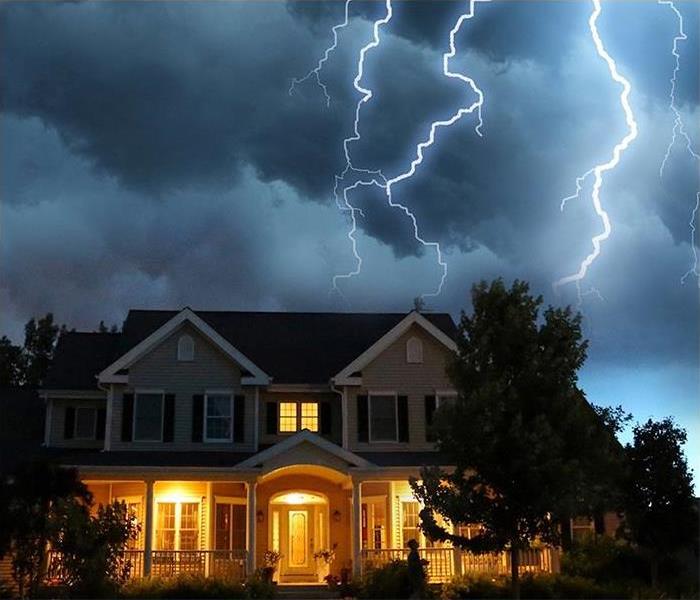 A lightning strike can cause damage all on its own and can lead to water or fire damage as well.
A lightning strike can cause damage all on its own and can lead to water or fire damage as well.
Whether you are a property manager or own a home, storms in Orlando and the surrounding area can be abrupt and severe, potentially causing damage to your property. Initial damage from these storms can occur in multiple ways including from rain, hail, wind, and even fallen trees. Knowing the possibilities of damage can help you prevent or prepare your property for future storms.
1. Damage from Rains
Orlando is no stranger to heavy and abrupt rainstorms. Strong downpours during a storm have the potential of washing away the granular surface on shingles. The rainwater can also travel under missing seal strips and damaged flashing. Damage from downpours can compromise your roofing system and lead to interior leaking and mold growth as well.
2. Damage from Hail
The size of a hailstone can vary but is usually between pea-sized and marble-sized. The force of these stones pounding down on your rooftop can cause tiny indentations in your roof or dents in the metal flashing of your roof. At a quick glance it may not appear so, but after taking a closer look you may possibly find compromises in the roofing membrane. This particular damage can affect your roof’s ability to prevent water from entering your home. Similar to rain, a persistent amount of hail can remove the granular surface of your roof shingles, which removes their ability to protect your home from UV rays and premature aging. This further increases your likelihood of sustaining extensive roof damage in future storms.
3. Damage from Winds
The most obvious wind damage to your roof is when winds are so strong that they blow your shingles off. Additionally, winds can lift or break a shingle’s sealing strips. Without these strips, water can get underneath your shingles. if not fixed immediately, the water that enters can cause mold growth, roof leaks and damage to interior insulation, plywood, and drywall. Undetected compromises in your roof that are exposed to future storms can even lead to a damaged underlayment causing roof rot to your decking.
4. Damage from Fallen Trees
Trees, or even just tree limbs, can cause damage beyond the visible hole they create in your roof. If the damage occurs during a storm, the hole in your roof provides incoming rainwater with access to other areas of your roof. This can weaken your roof structure and also create mold growth. Even if a fallen tree does not create a hole in your roof, cracks in your rafters or punctures in your shingles or other roofing materials can also lead to water damage.
5. Lightning Strikes
Although it is not common, lightning has caused damage to residential and commercial properties in the past. In just a few seconds, your home can go from perfectly sound to severely damaged from one strike of lightning. Roofs often take a major hit, and metal gutters are especially susceptible, too. A bolt of lightning can puncture a roof, sear the surrounding materials, and tear through attics. A powerful enough strike can tear off shingles and gutters, leaving the roof a disaster. In addition to leaving your home exposed to water damage, a lightning strike can also potentially cause a fire, increasing the amount of damage.
Has Your Roof Experienced Storm Damage?
If you have sustained damage to your roof and property after a storm, SERVPRO of Winter Park can assist you with water extraction and drying your property. While your roofing company makes sure to fix the damage to your roof, we make sure you are not sustaining long-term damage in all areas of your property. Give us a call at any hour in Orlando at 407-678-5391!
15 Storm Damage Prevention Tips Every Homeowner Should Know
3/22/2018 (Permalink)
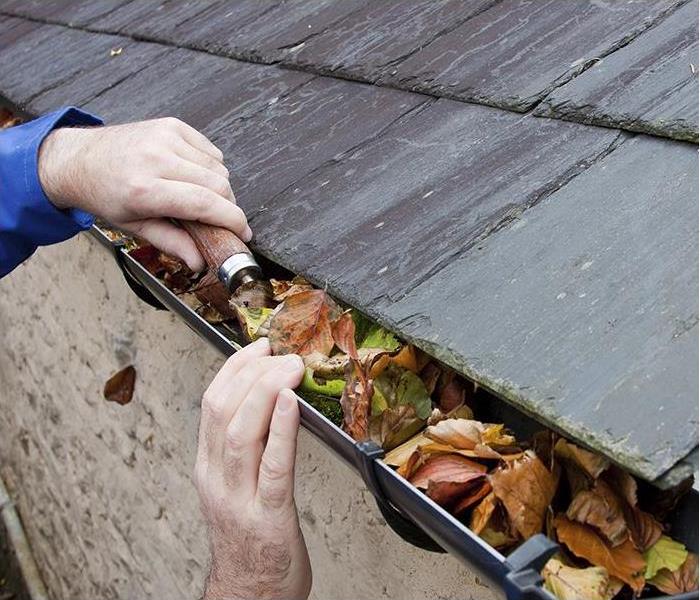 Cleaning your rain gutters regularly can help prevent leaks and water damage to the exterior an interior of your home.
Cleaning your rain gutters regularly can help prevent leaks and water damage to the exterior an interior of your home.
Spring has finally come. Floridians know that aside from a rise in temperature, lots of rain and thunderstorms are on the way. As an industry leader in storm damage, SERVPRO has extensive knowledge of what it takes to both prevent damage as much as possible and thoroughly assess a property for damage once a storm has passed. Here are some tips to help you adequately prepare for the storms to come.
Storm Preparation Tips
Preventing Water Damage
- Perform roof inspections regularly and search for shingles that are loose or curled. This applies to wind damage prevention also.
- Properly grading your lot will help to prevent water from seeping into your property.
- Proper drainage of your gutters is crucial for preventing leaks. Make sure to clear gutters and downspouts of any debris regularly.
- Weather Stripping can be applied around doors and windows for a reduction in air and water leaks.
- Search the property’s foundation walls and basement floor for any cracks and seal them completely.
Preventing Wind Damage
- Minimize potential damage by replacing rock and gravel landscaping materials with shredded mulch.
- Protect windows and glass doors by installing impact-resistant shutters or boarding up.
- Relocate your outdoor items indoors and secure the items that can not be moved.
- Make sure to trim down trees and shrubbery. Weak trees that may fall should be removed completely.
- Park any vehicles away from trees, lampposts, and power lines.
Preventing Hail Damage
- Make sure delicate outdoor items, furniture, and glass are covered and protected from potential hail impact.
- During a hailstorm, keep doors and windows completely closed for the duration of the storm.
- For added protection, install UL 2218 or FM 4473 as Class 3 or 4 roof shingles.
- If you have a garage, keep your vehicles parked inside with the garage door completely closed.
- If you do not have a garage or have more vehicles than your garage can fit, cover your vehicle(s) with a tarp to protect the paint. For added protection against dents and broken windows, try covering your vehicle with a thick blanket prior to tarping.
Local Storm Damage Help
If you follow the tips listed above, you have a higher chance of preventing serious damage to your home and property during a storm. However, disaster can strike at any time, so should you receive damage after a storm, SERVPRO of Winter Park is ready to assist you. Our phone lines are open 24/7 and our highly skilled technicians are available for services like water extraction and water damage restoration. For more details, give us a call at (407) 678-5391.
Florida State of Emergency: 5 Steps to Prepare Your Home for Hurricane Matthew
10/4/2016 (Permalink)
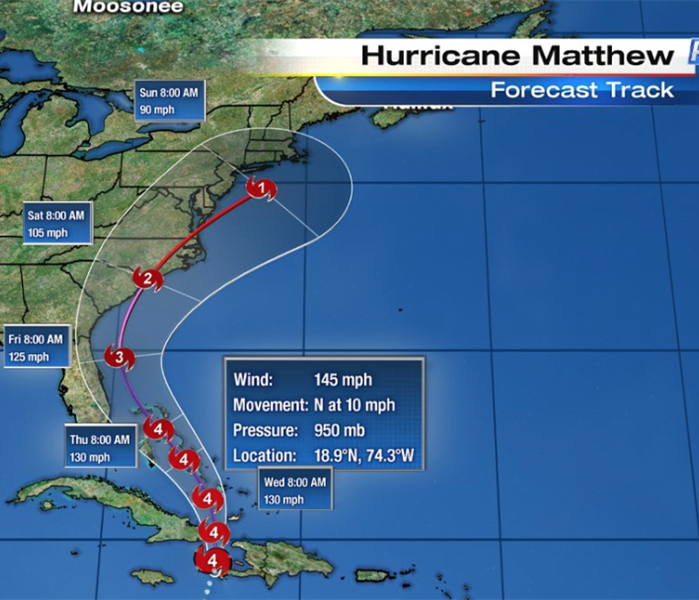 Path of the Hurricane
Path of the Hurricane
Its been 12 years since Central Floridians were socked with 4 devastating hurricanes: Charley, Frances, Ivan and Jeanne. Charley was the first of these storms to hit Orlando, and the worst to hit Florida since Andrew in 1992. When hurricane Charley made landfall as a category 4, winds got up to 150 mph causing $15 billion in damage. Driving wind and rain flooded homes across the state of Florida.
Once again, Florida is in a State of Emergency and SERVPRO of Winter Park is ready. When the storm rolls In, we roll out. Just as we have been getting ready for the tropical cyclone here in our office, its equally important for you to protect your home.
How to Prepare Your Home for Hurricane Matthew:
- Internet may be out. Searching for phone numbers online may not be an option. Before the storm strikes, make sure all of your emergency contact numbers are listed on paper and posted in a visible place where everyone can see. This includes your insurance agency’s phone number, your policy number and your emergency restoration service provider, SERVPRO of Winter Park: 407-678-5391.
- Put together a good first aid kit, including bandages, tape, scissors, antibiotic cream, aspirin and an antiseptic wash in the event that water supplies become tainted. In addition, have any and all prescriptions filled, in the case your pharmacy might be closed for days or weeks.
- Stockpile hurricane supplies such as canned and dried food, bottled water, batteries, flashlights, candles, matches, propane for gas grills and ice.
- Place sandbags around the perimeter of your home, especially if your house is in low lying or flood zone areas.
- Keep heavy duty plastic and tarps handy along with durable tape, nails and a hammer. If any side of your home is exposed to the elements, consider covering windows with plywood.
Once again its time to hunker down, stay inside and stay tuned to your local news station for updates on the hurricane. As always, you can depend on your neighborhood family restoration business, SERVPRO of Winter Park. We are here for you to help make it like it never even happened!





 24/7 Emergency Service
24/7 Emergency Service












